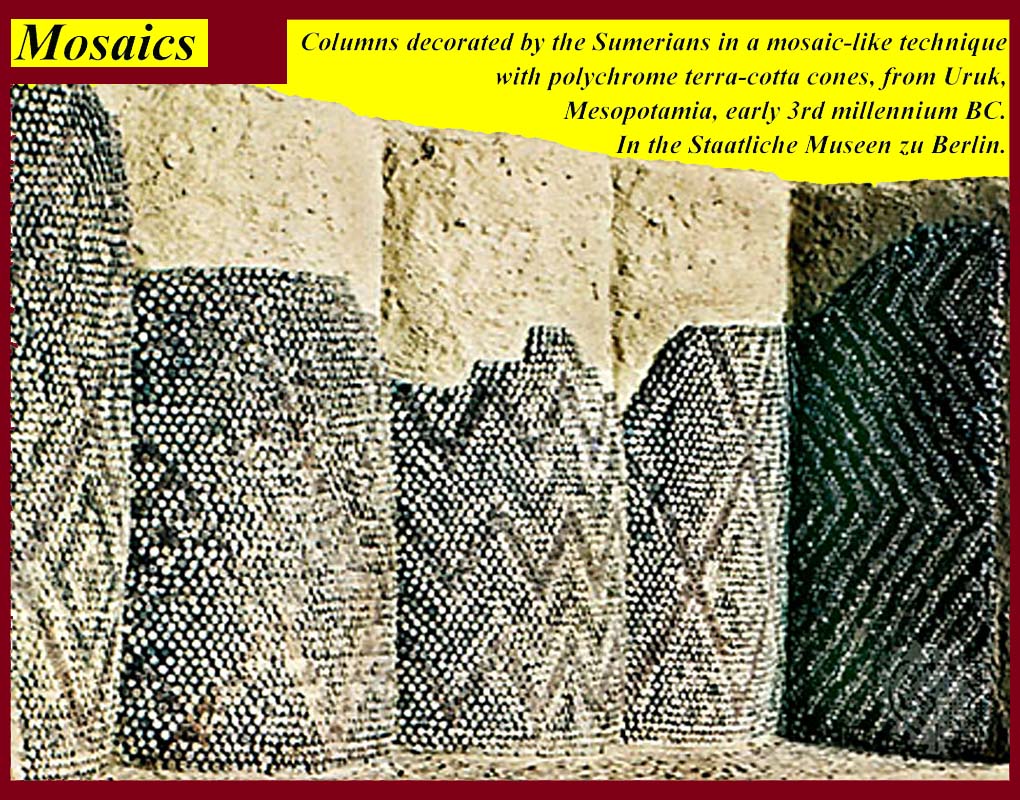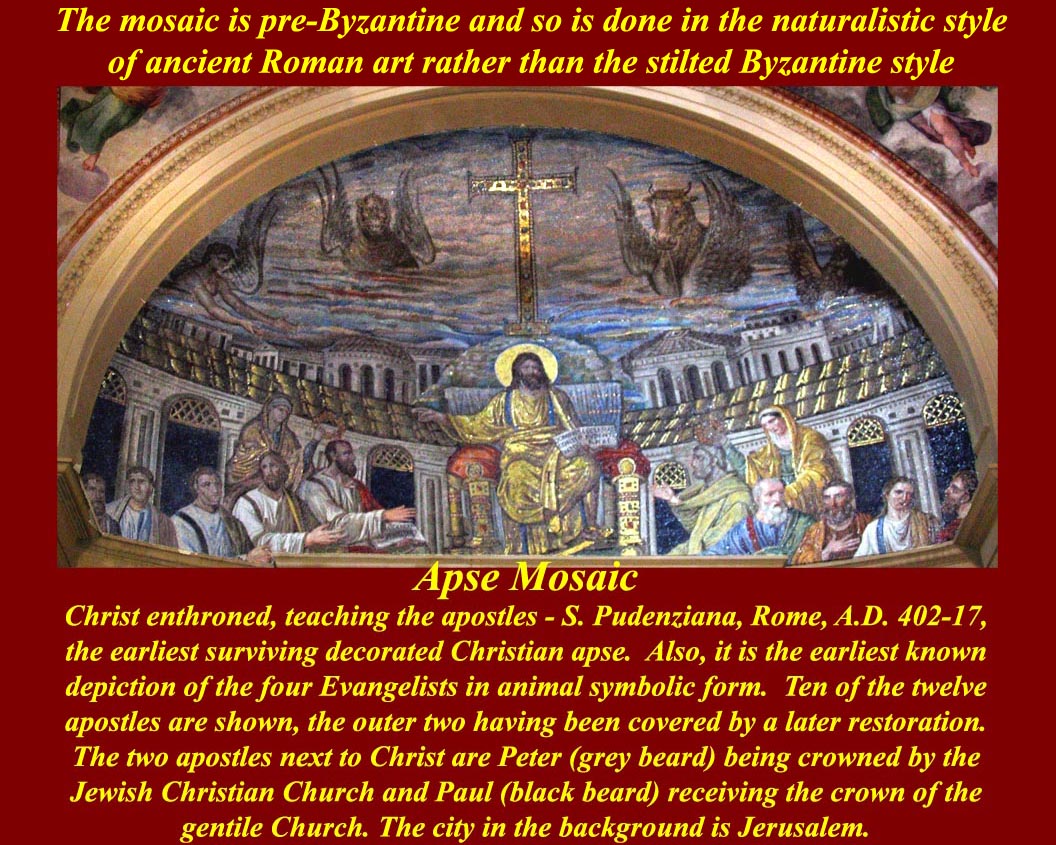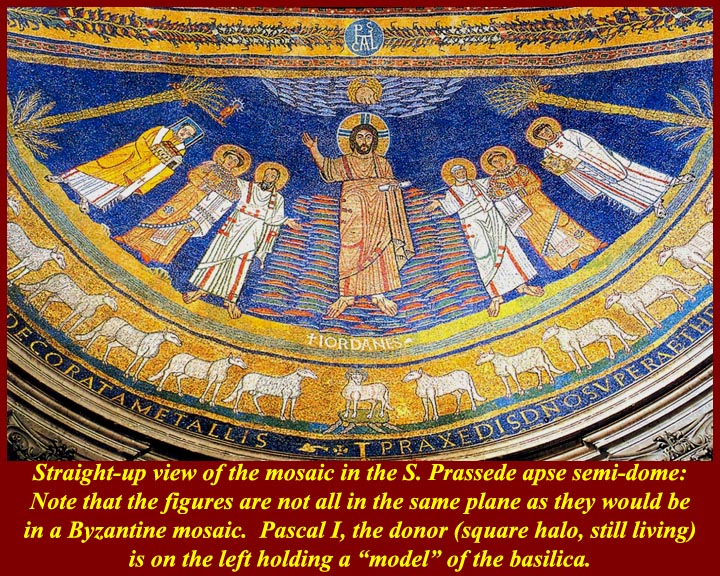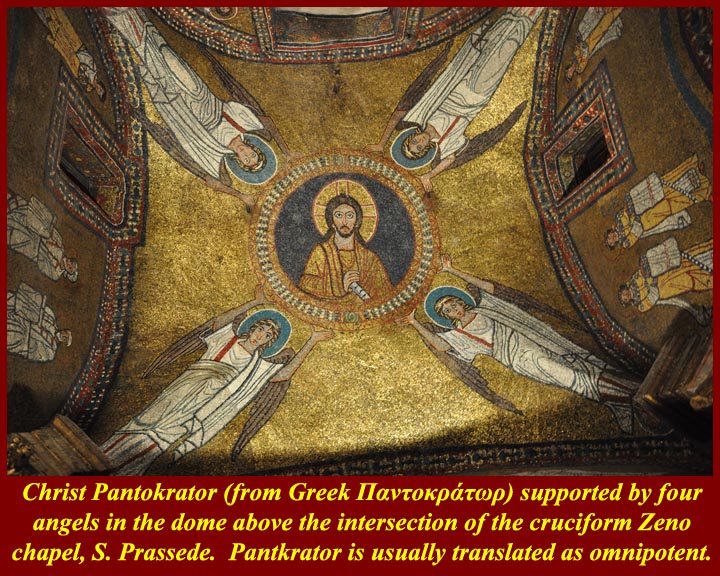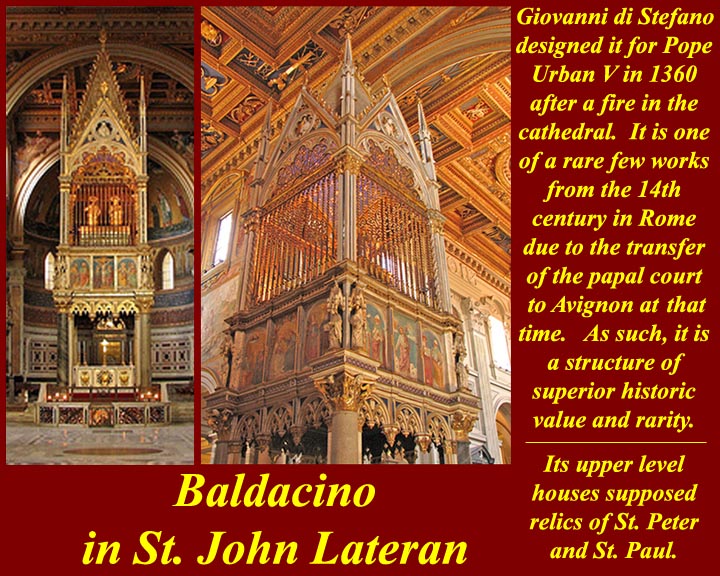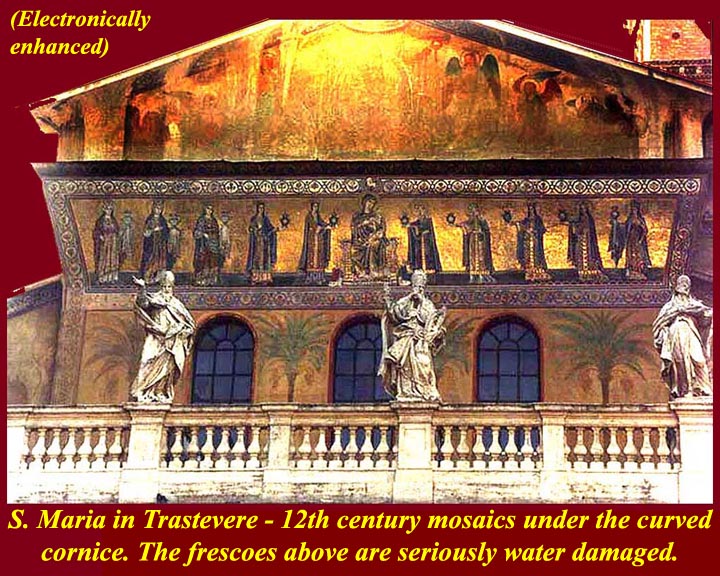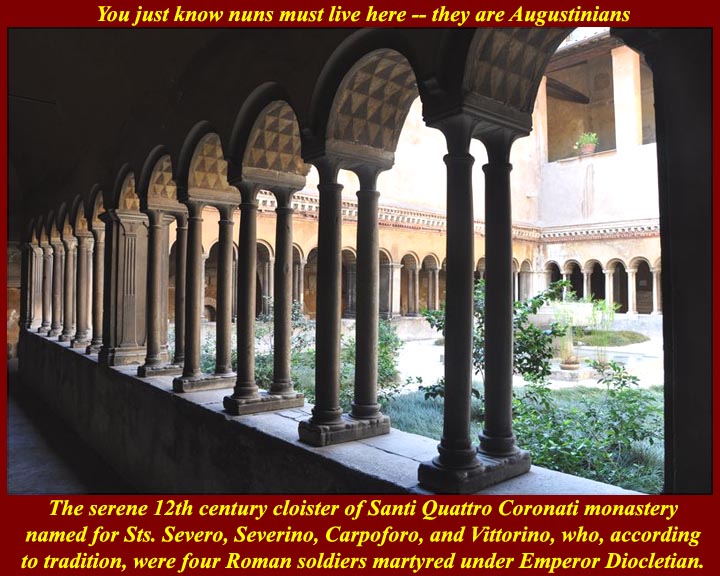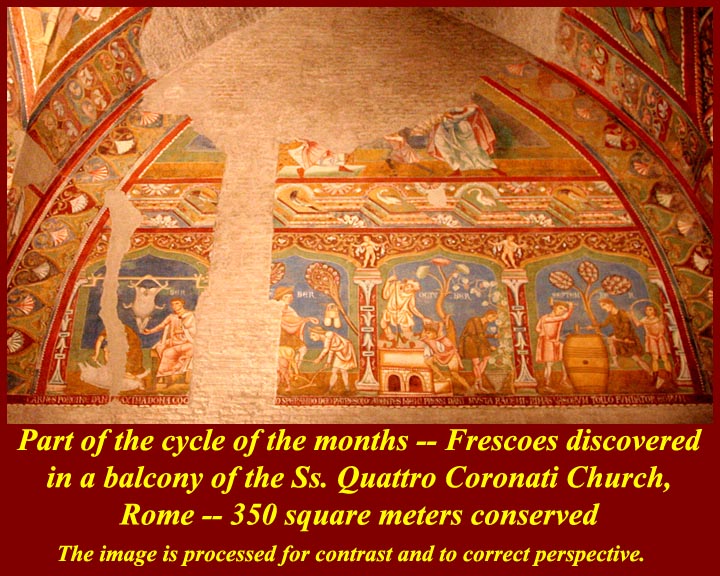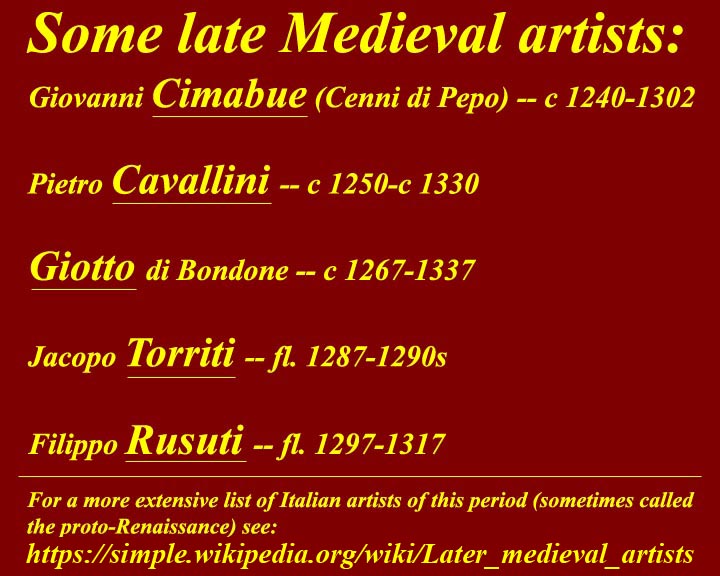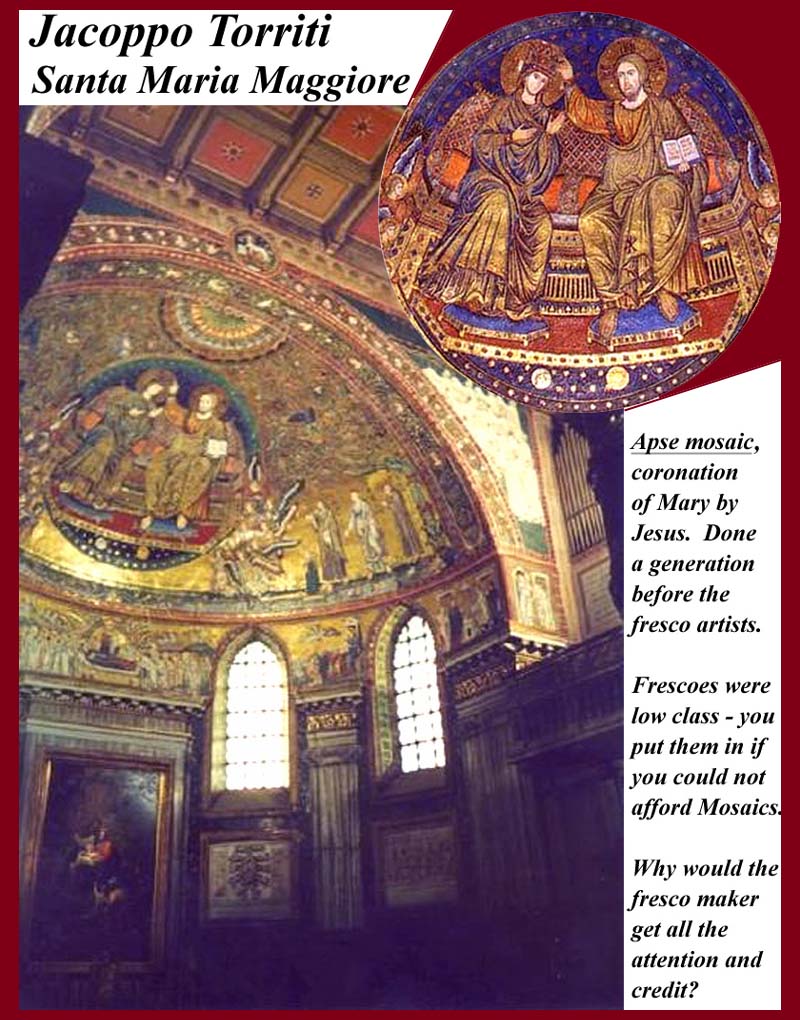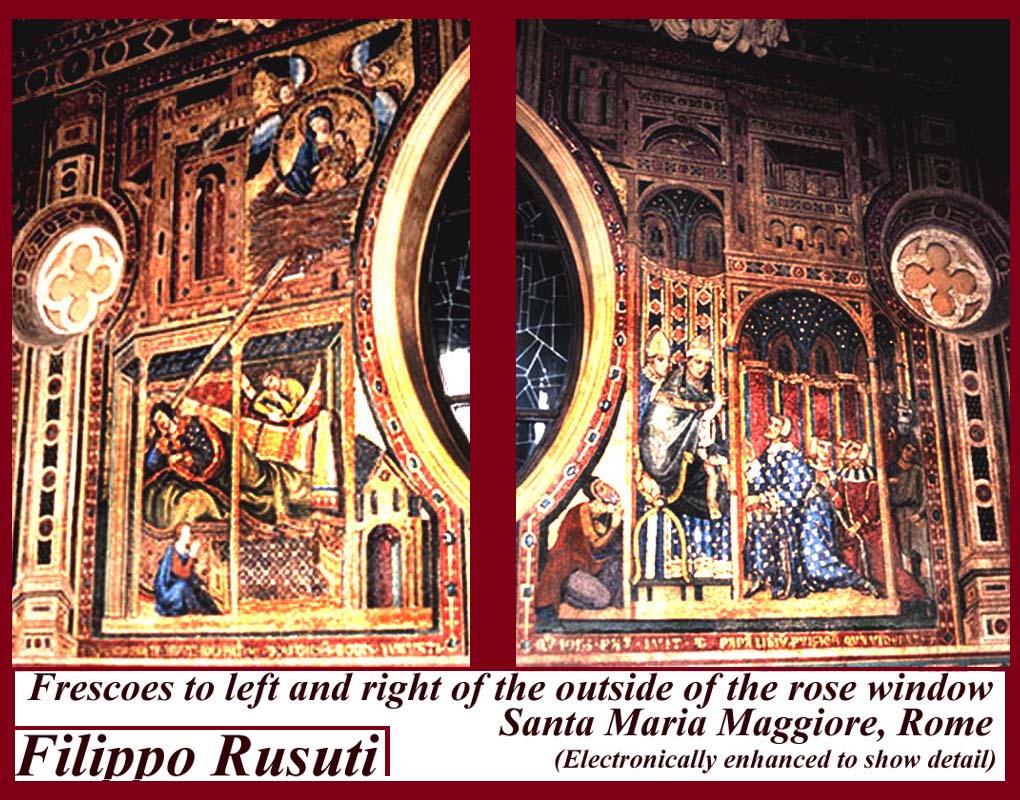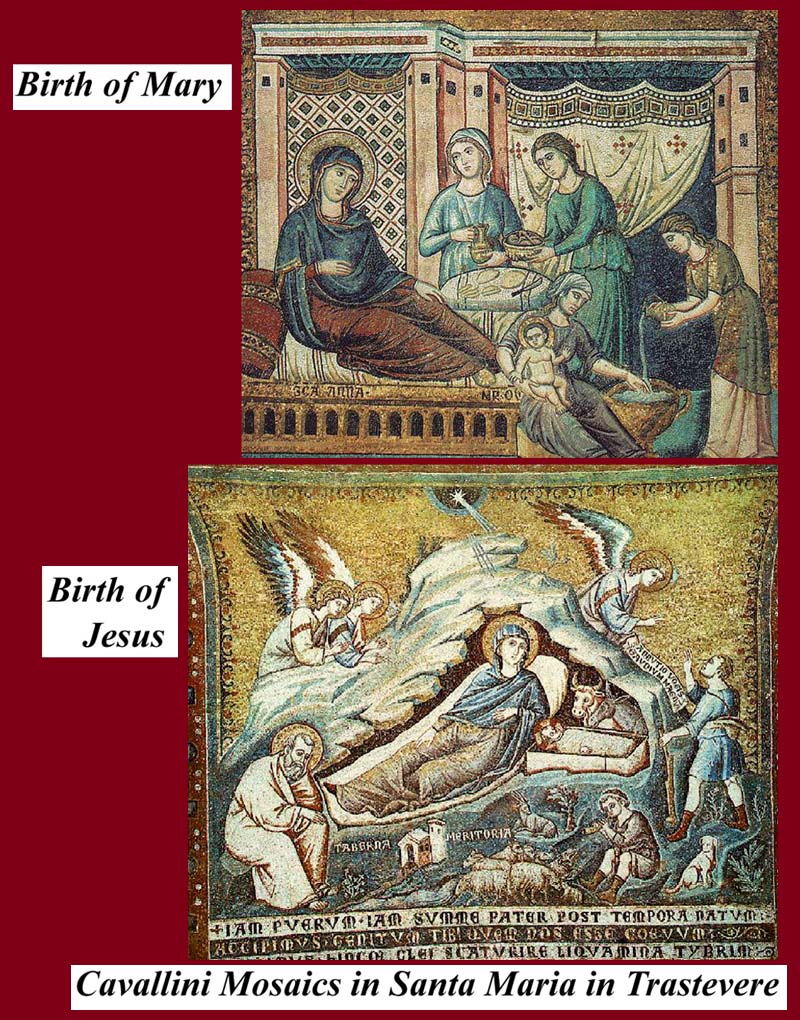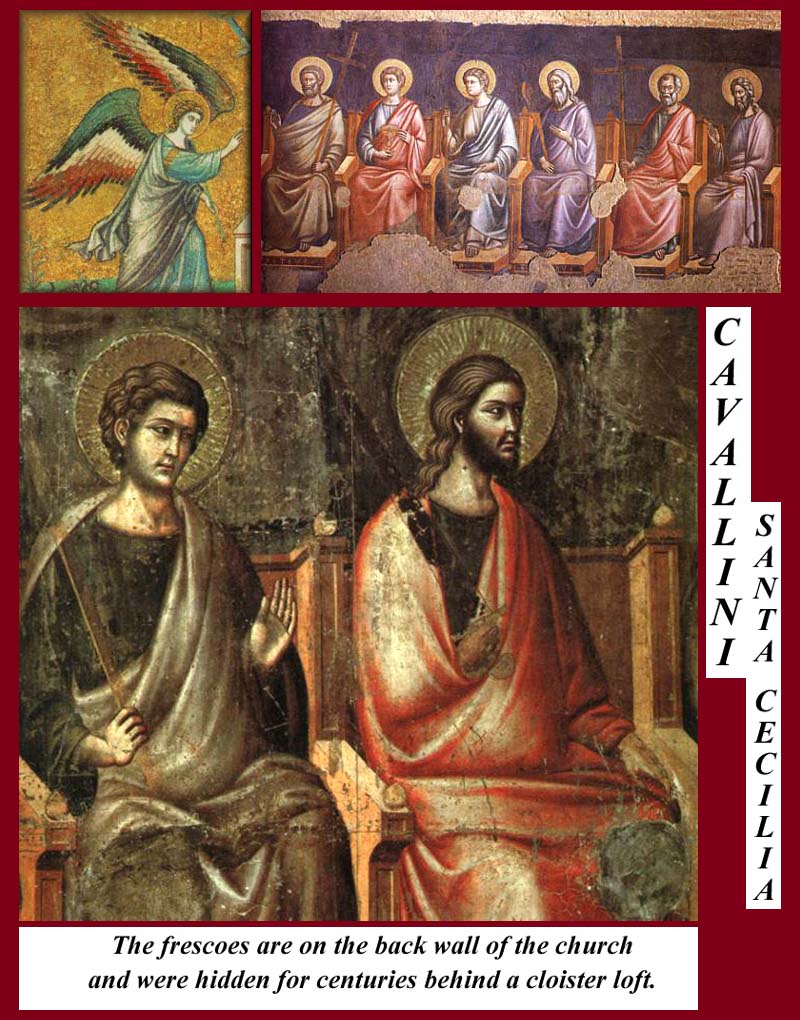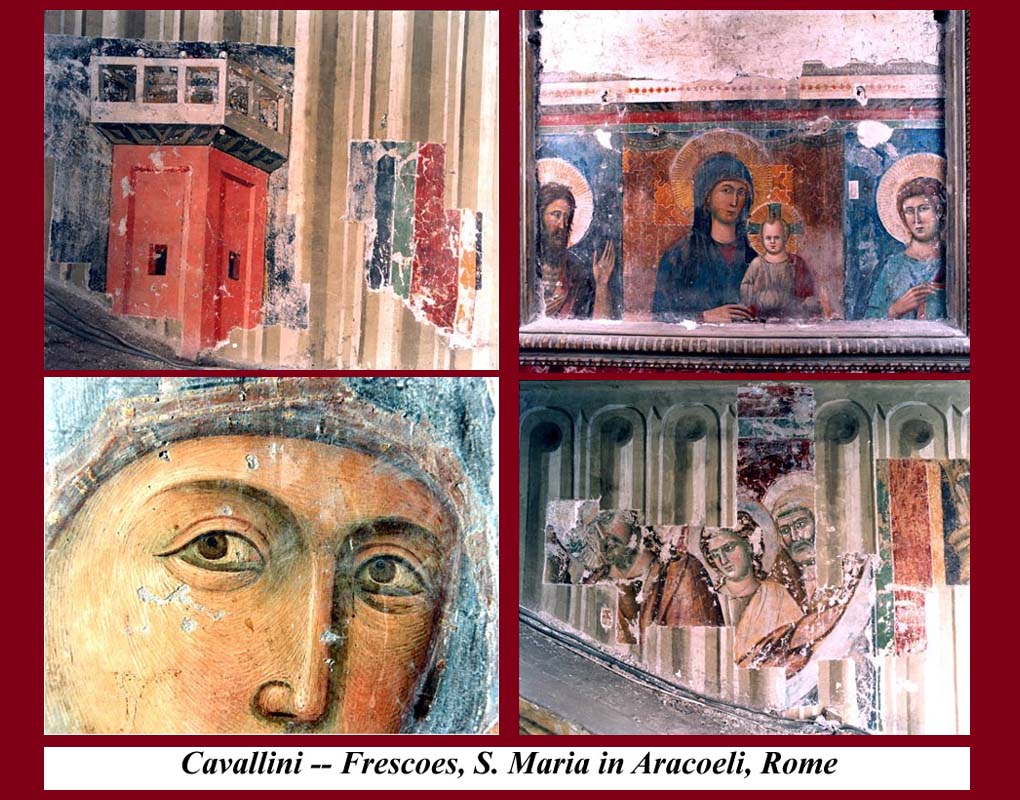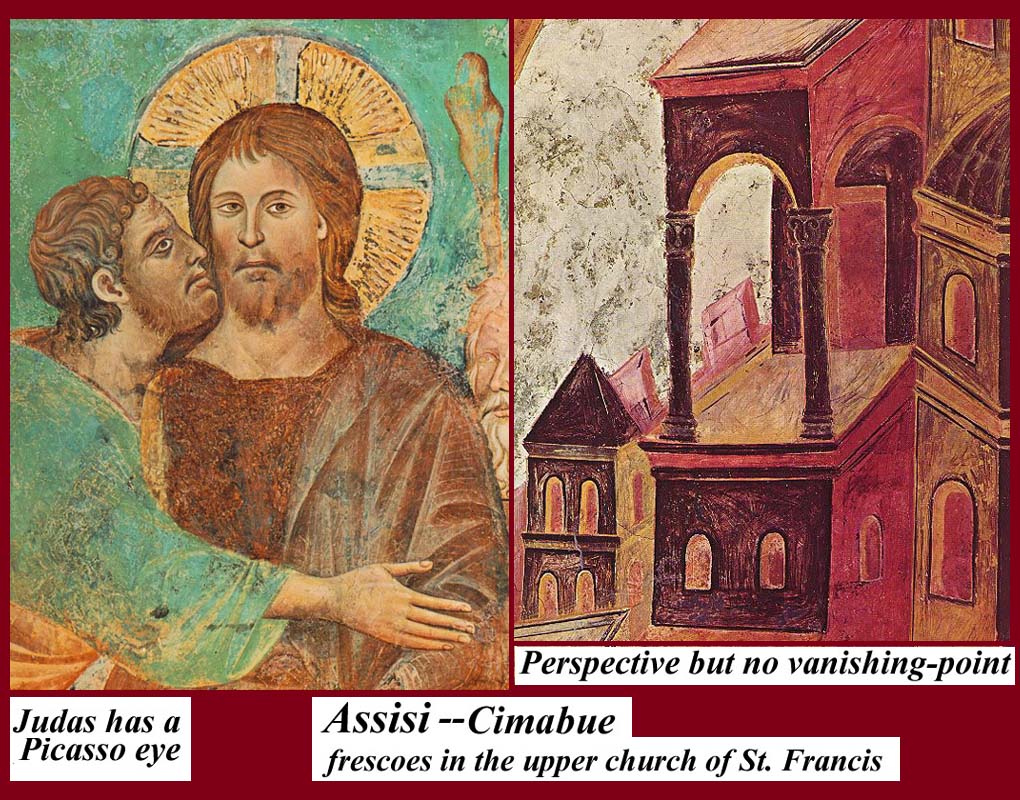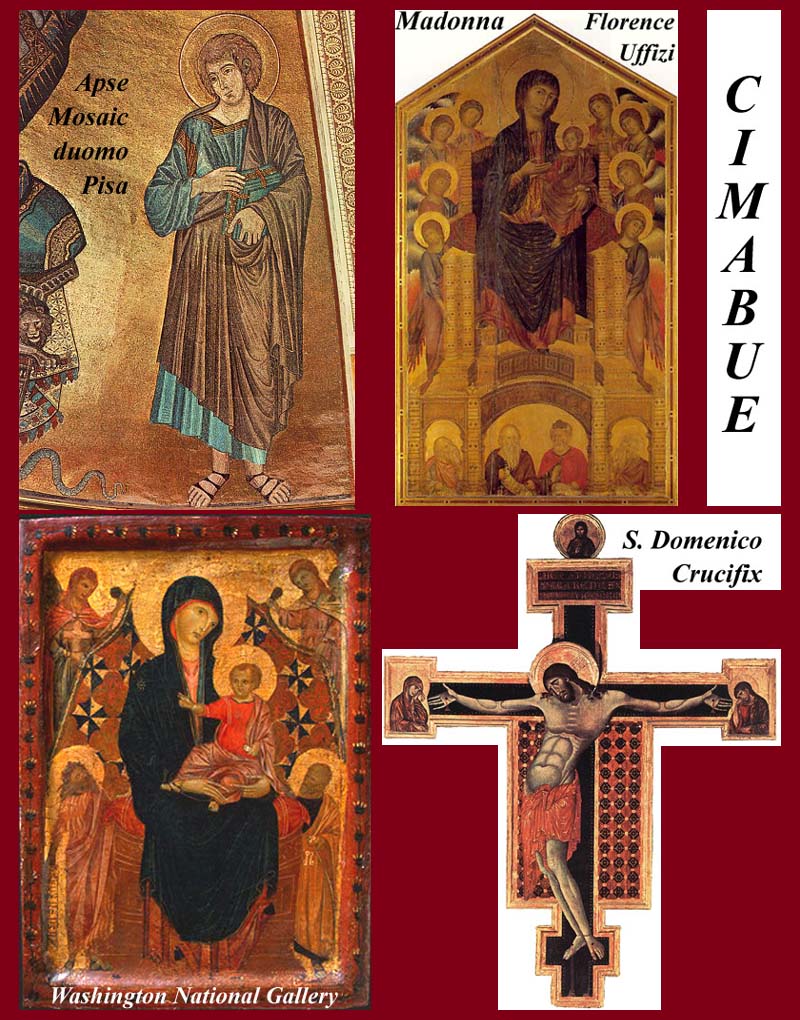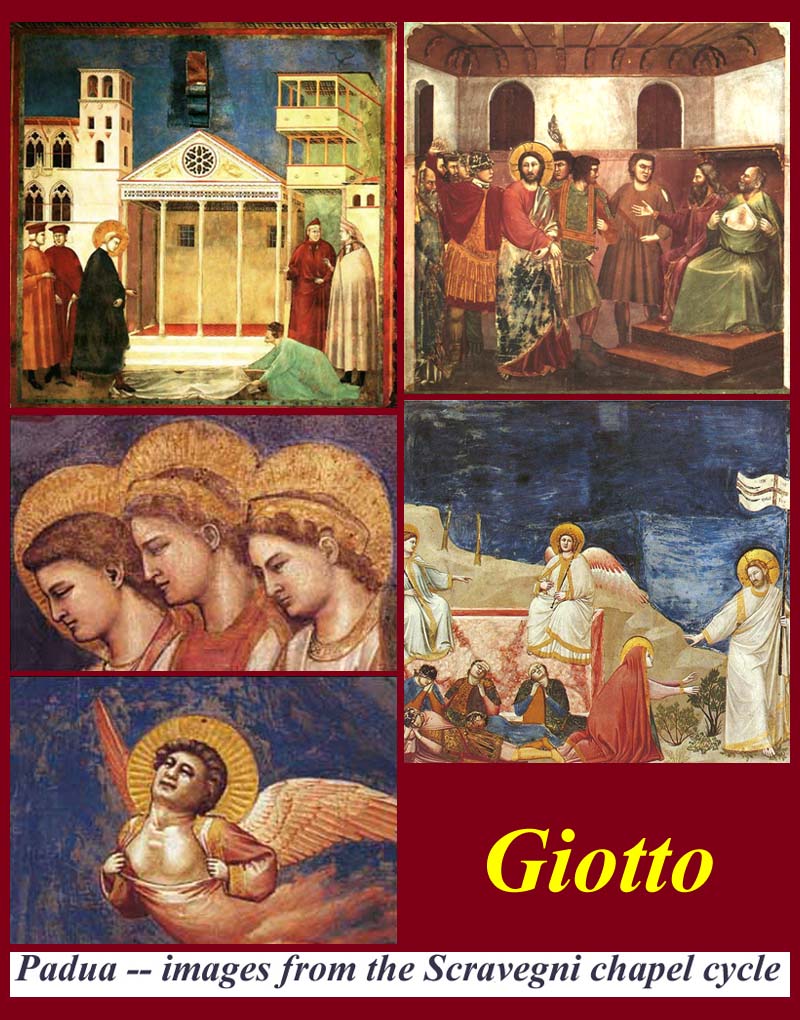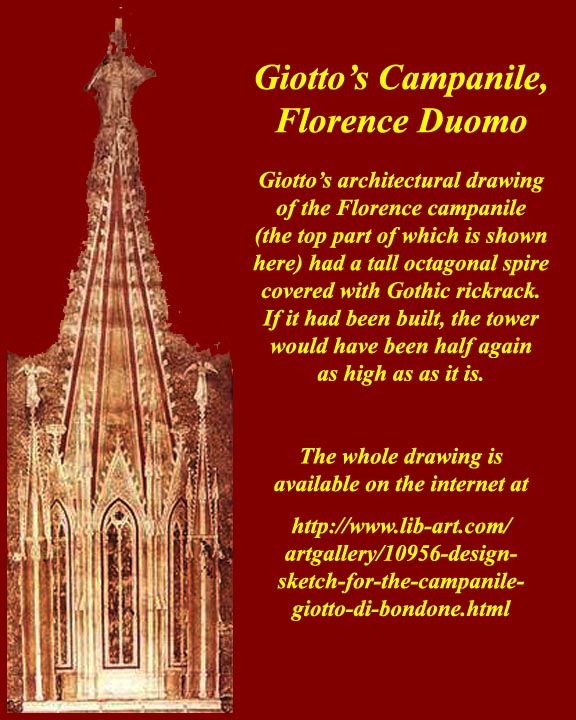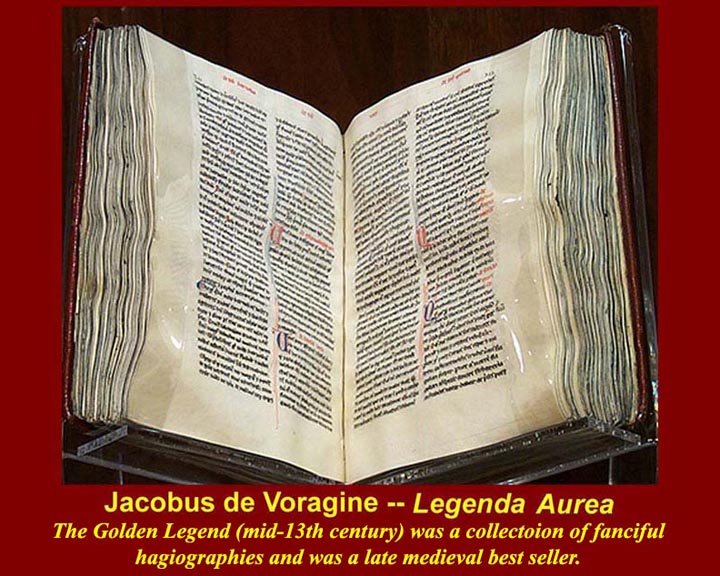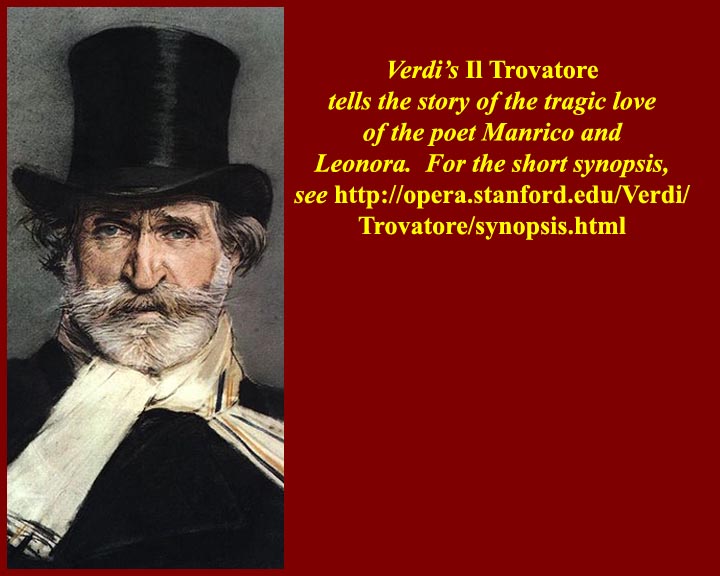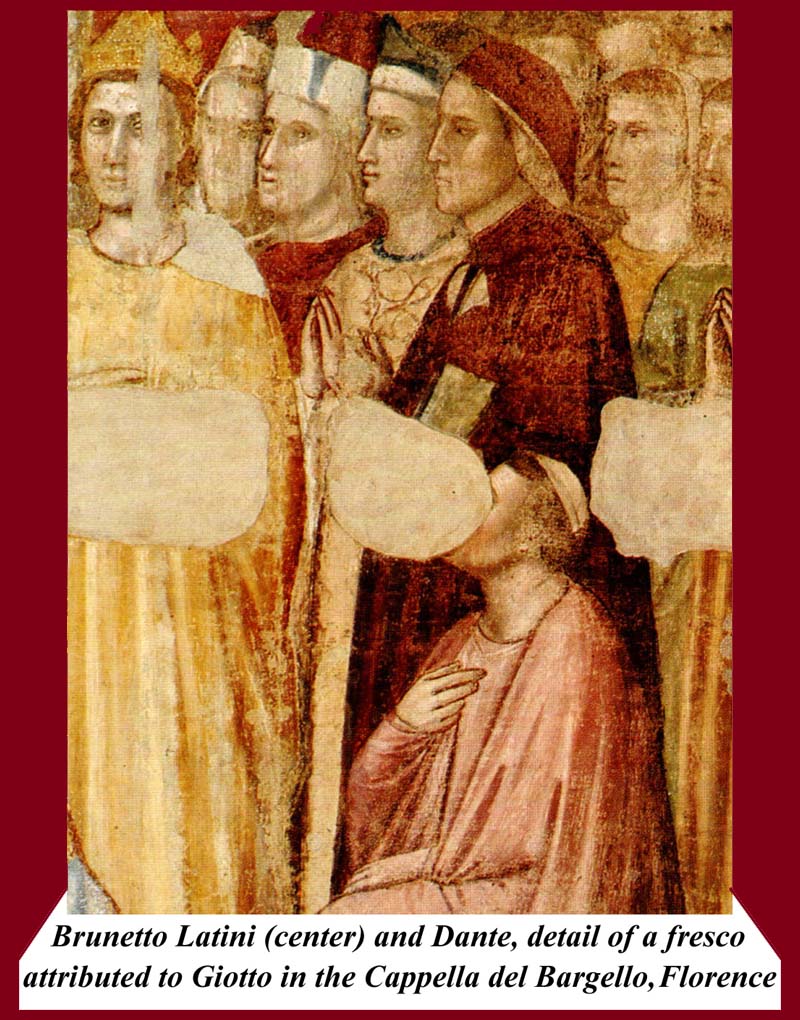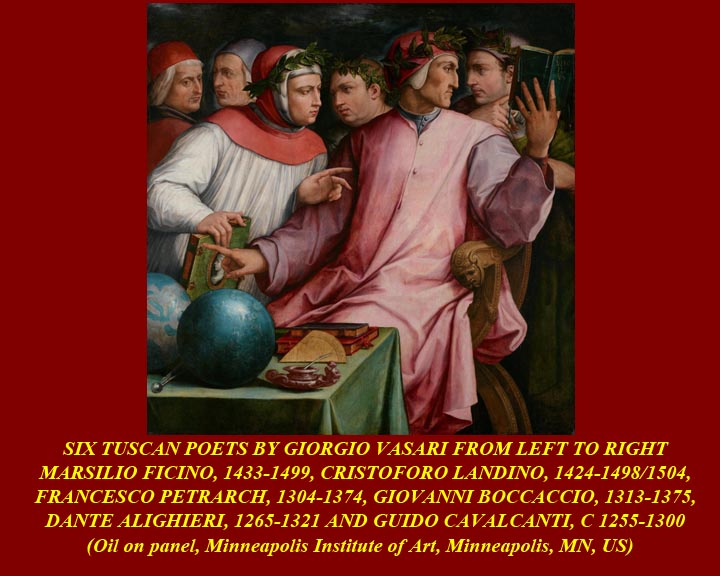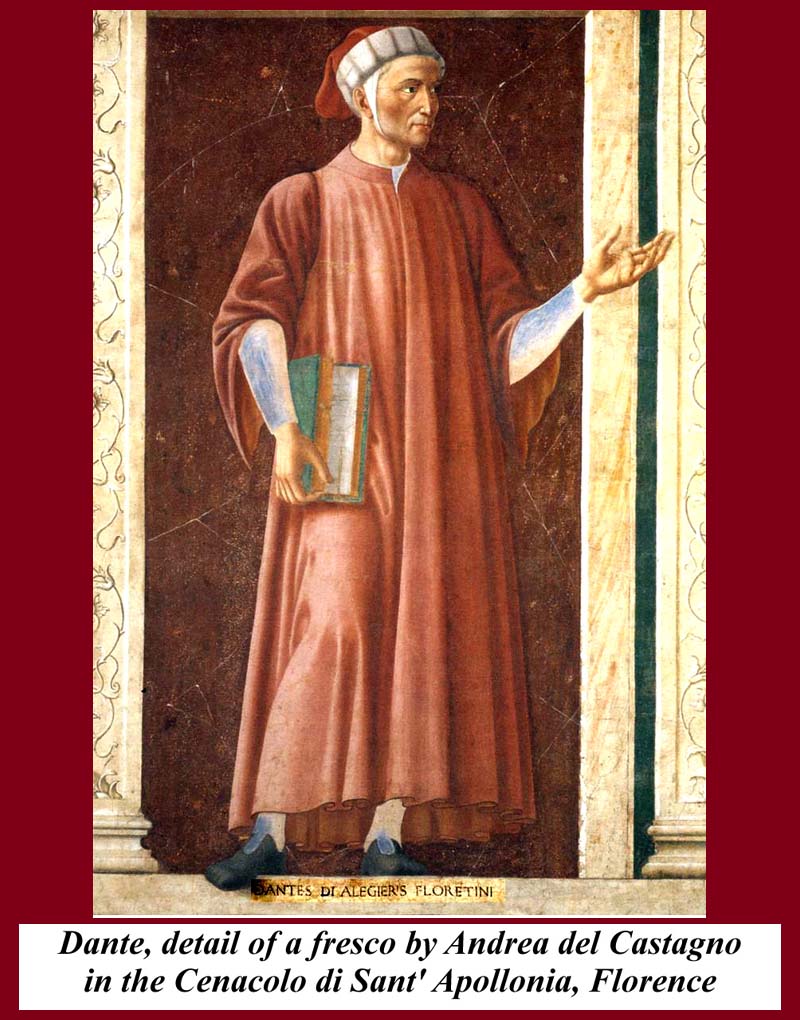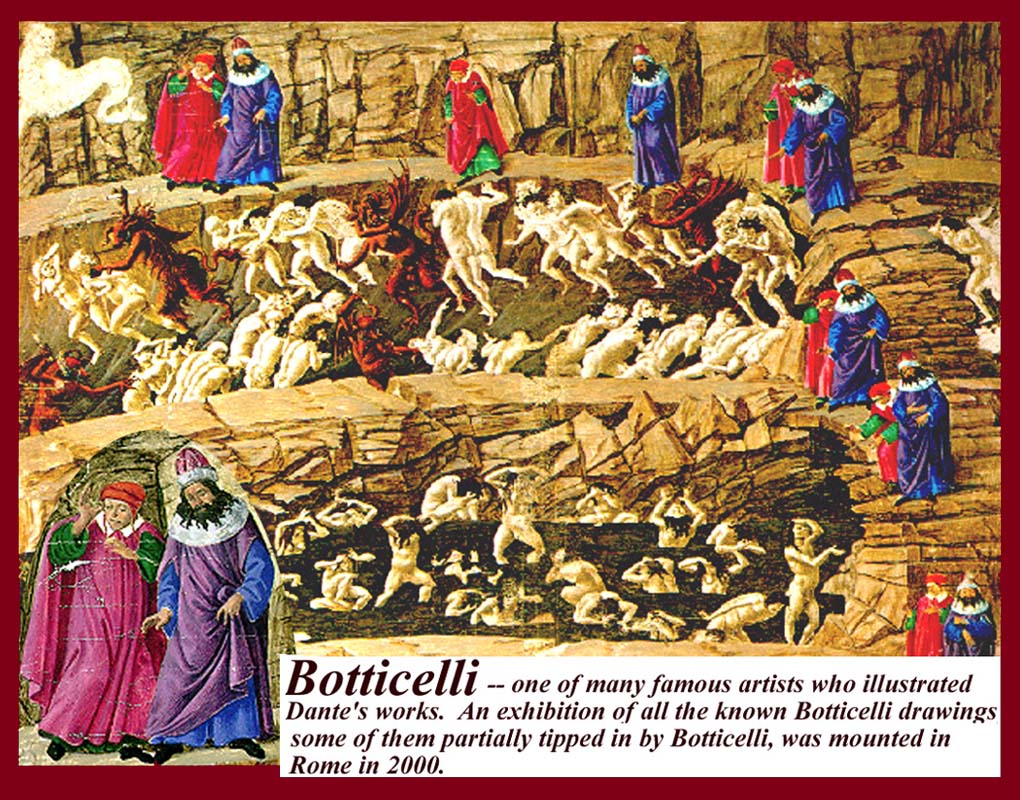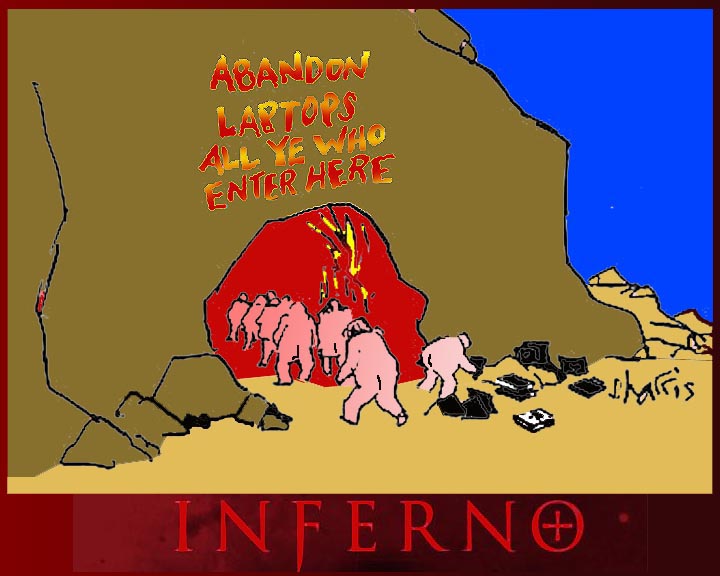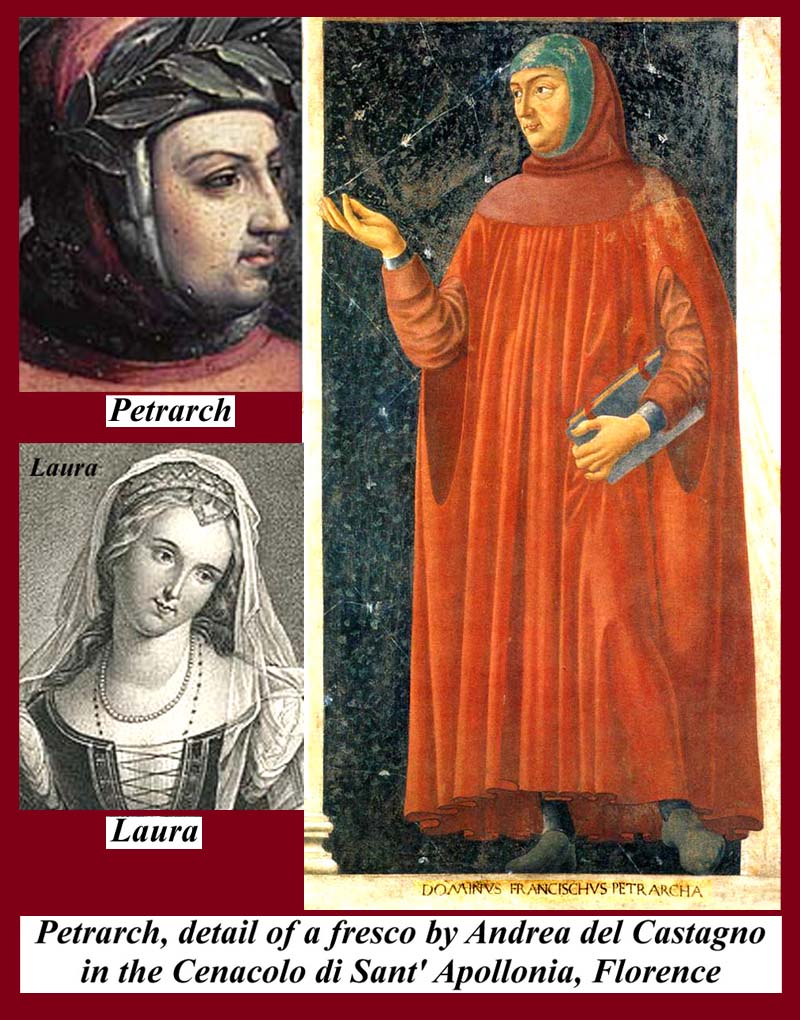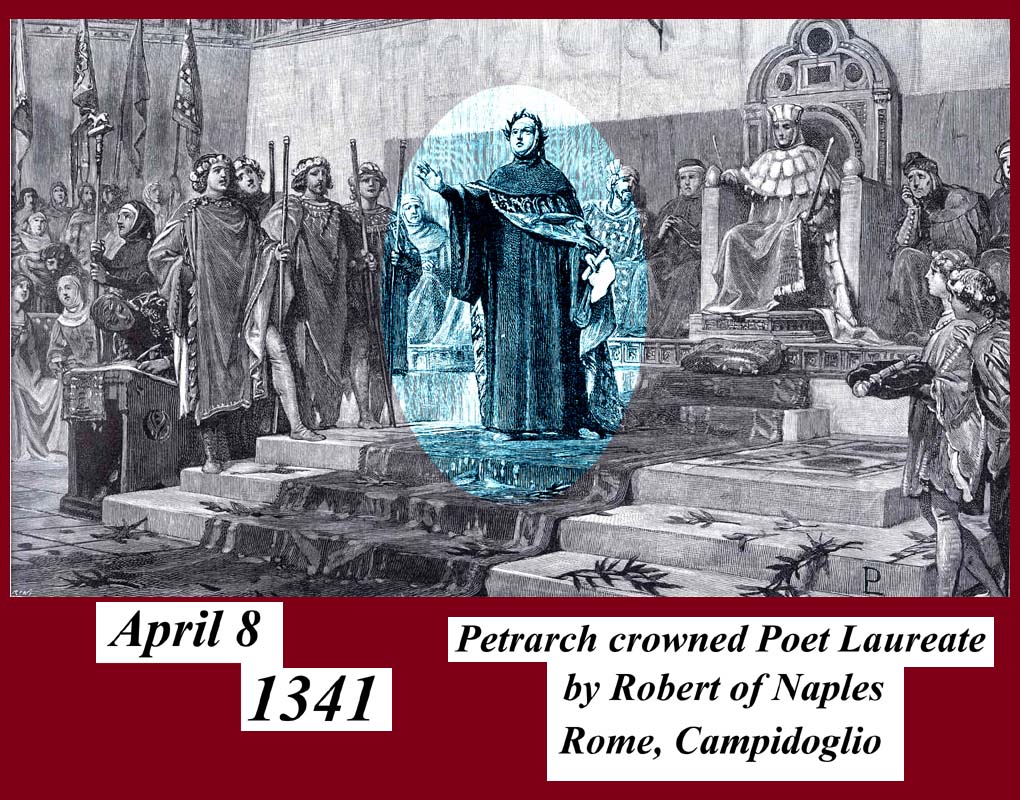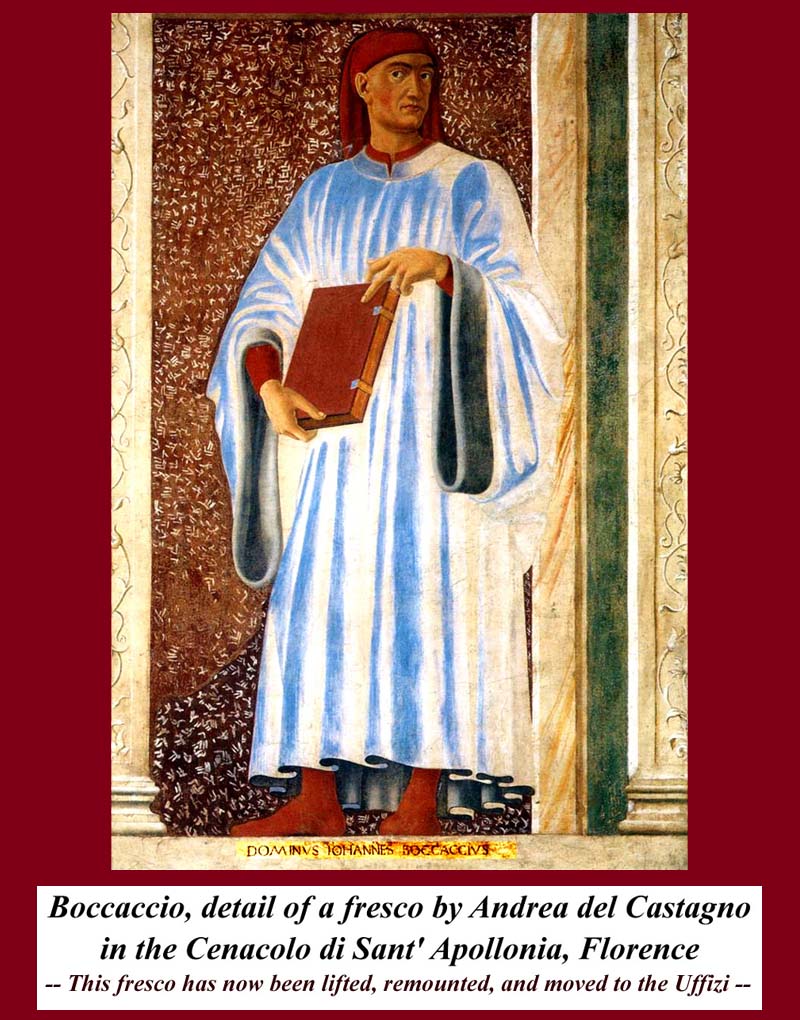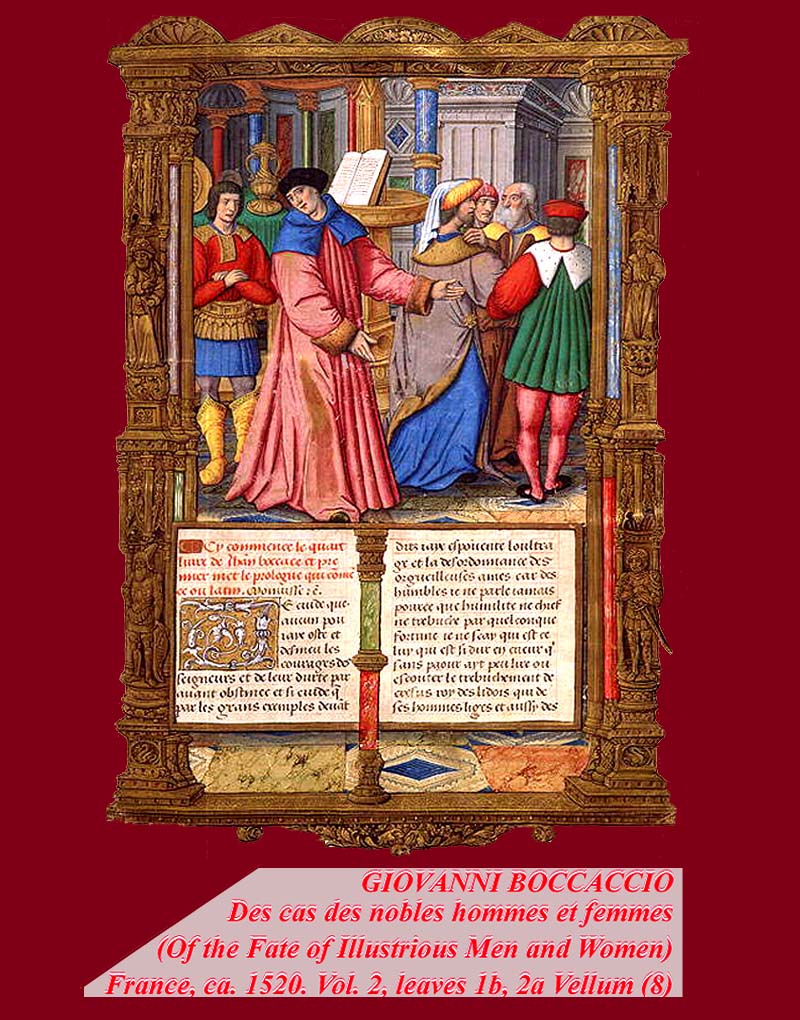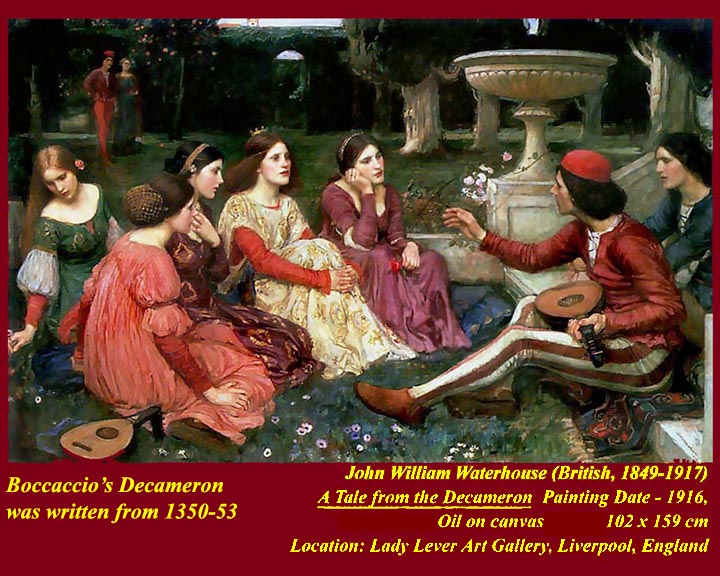Late Medieval artists and writers
Use Click on links or small images below to view larger images for Unit 9
Art
http://www.mmdtkw.org/MedRom0901EarliestMosaic.jpg
First known "mosaic", Uruk, Mesopotamia. Mosaics, in general, require less technology than frescoes. For mosaics you only need to set colored stones in mortar. For frescoes you need a formulary of powdered pigments. Nonetheless, mosaics have always been more expensive that frescoes, because mosaics are much more labor intensive. Floor mosaics are fairly durable; gravity holds the tesserae in place even if the mortar is weak or if it is degraded by age and weathering. Wall and ceiling mosaics have to fight against gravity; tesserae will drop if the mortar deteriorates. Frescoes will stay on walls indefinitely as long as the plaster isn't broken and as long as capillary action doesn't cause water to penetrate from behind or below.
http://www.mmdtkw.org/MedRom0901gApseMosaicSPudenziana.jpg
The apse mosaic (402-417 AD) in Santa Pudenziana church, Rome, is pre-Byzantine and so is done in the more naturalistic style of ancient Roman art rather than in the stilted single plane Byzantine style. Christ is shown teaching the twelve apostles (some of whom are wearing Roman senatorial togas). Only the upper halves of ten of the apostles are visible, the other two and the lower halves of the visible ten having been covered by the later addition of the arch and other architectural elements above the altar. This is also the first known image showing the four evangelists in their animal symbolic form. The two apostles next to Christ are Peter and Paul being crowned by the personified Jewish Christian Church (Peter -- grey beard) and the personified gentile Church (Paul -- black beard). The city in the background is Jerusalem.
For more information and images, see http://www.understandingrome.com/2013/01/14/roman-christian-ness-or-christian-roman-ness-the-apse-mosaics-of-santa-pudenziana-2/.
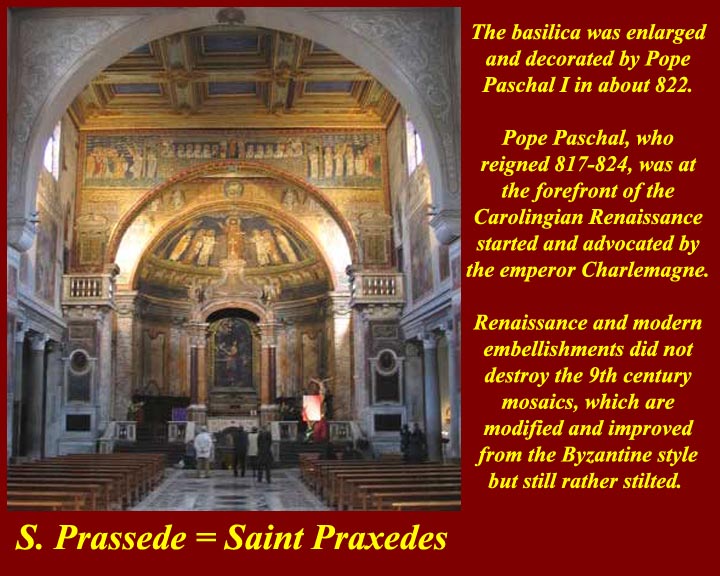
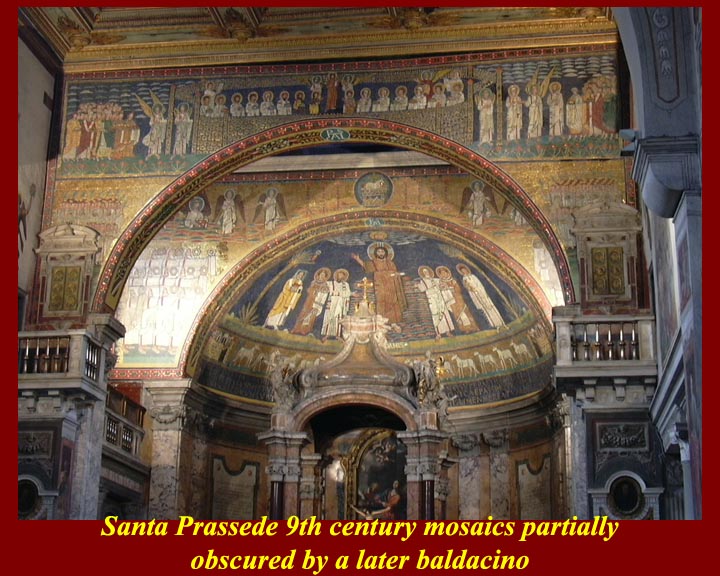
http://www.mmdtkw.org/MedRom0901hPrassedeInterior.jpeg
http://www.mmdtkw.org/MedRom0901iPrassedeMosaics.jpg
http://www.mmdtkw.org/MedRom0901jPrassedeApseMosaic.jpg
S. Prassede (Praxedes) was enlarged and decorated by Paschal I in about 822 AD. Paschal was at the forefront of the Carolingian Renaissance in Rome. Renaissance and modern refurbishing of the church, visible at the sides of the church, preserved Pascal's mosaics which are modified and improved from the Byzantine style but are still rather stilted; the figures face straight ahead as they would in a Byzantine mosaic, but, if you look closely at the apse mosaic, you can see that Peter and Paul each have an arm over the shoulder of an adjacent saint, which is both less formal than anything you would see in a Byzantine work and also requires Peter and Paul to reach behind the plane of the image. Paschal is shown on the far left (but Christ's right) holding an architectural model of the S. Prassede church, of which he is the builder, and having a square halo -- sainted but still living at the time the mosaic was installed. The Jordan River flows below the feet of the figures and is labeled.
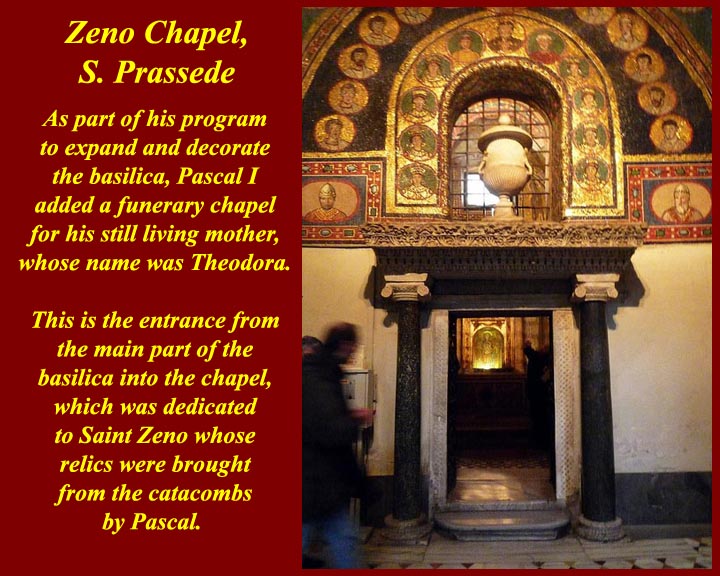
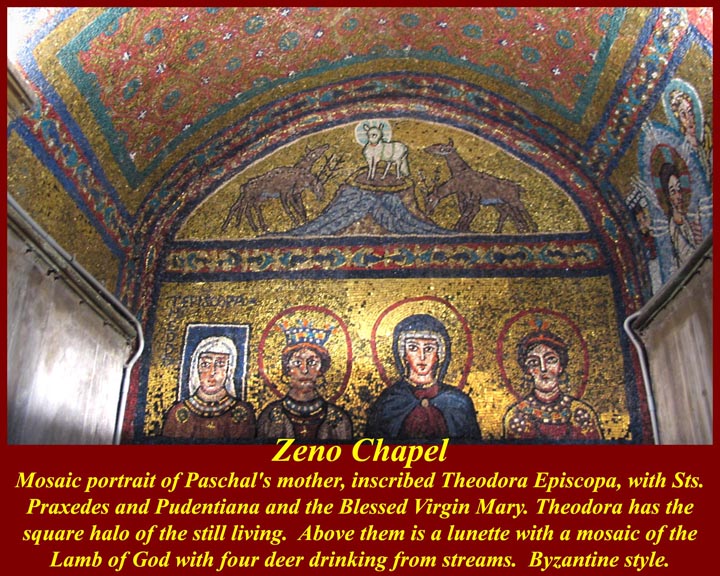
http://www.mmdtkw.org/MedRom0901kZenoChapel.jpg
http://www.mmdtkw.org/MedRom0901laZenoChapelTheodoraAgnusDei.JPG
http://www.mmdtkw.org/MedRom0901lbZenoPantokrator.jpg
Paschal also decorated a funerary chapel for his mother, who was still alive when the chapel was decorated (square halo again). Her image is labeled Theodora Episcopa, and that detail has been claimed by some as evidence that there were women priests in the Roman Catholic Church at least into the 9th century.
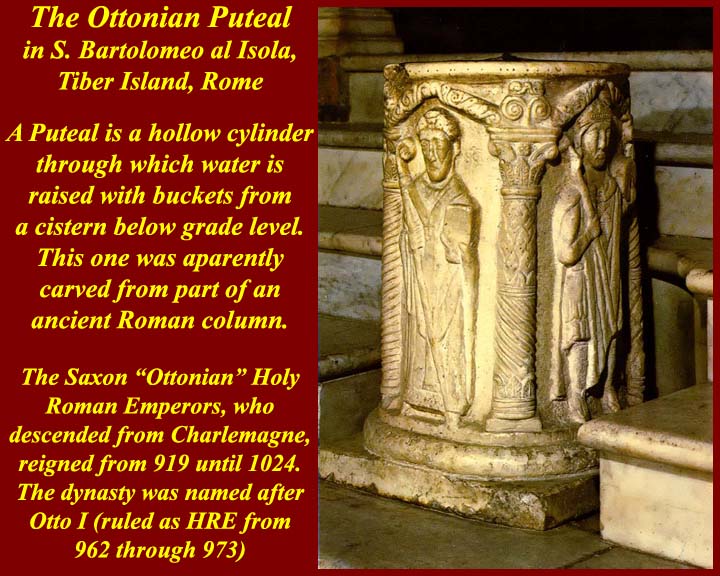
http://www.mmdtkw.org/MedRom0901mSBatolomeoOttonianPuteal900s.jpg
http://www.mmdtkw.org/MedRom0901nBaldacinoLateran.jpg
What followed the Carolingian Renaissance? In pre-Romanesque Germany, the prevailing style was what has come to be known as Ottonian art. With Ottonian architecture, it is a key component of the Ottonian Renaissance (circa 951 – 1024) named for the emperors Otto I, Otto II, and Otto III. The style persisted past the Ottonian emperors, however, and into the reigns of the early Salians. Ottonian art spread into Italy, but only a few examples survive in Rome.
The Ottonian Puteal in S. Bartolomeo Church on Tiber Island was carved from a drum of an ancient Roman marble column. A puteal is a hollow cylinder that is placed on top of a well or cistern though which water can be drawn -- it's supposed to keep folks from falling in.
The Ottonian baldacchino (canopy over an altar) in St John Lateran is said to hold the heads of both Peter and Paul.
See http://en.wikipedia.org/wiki/Ottonian_art and
http://en.wikipedia.org/wiki/San_Bartolomeo_all'Isola.
http://www.mmdtkw.org/MedRom0902MTrastMosaics.jpg
Santa Maria in Trastevere facade mosaics. On the front of the church above the Renaissance balcony the the 12th century mosaic shows Mary and ten virgins carrying lamps (the "Wise and Foolish Virgins" in Matthew 25:1-13). The mosaic is mounted on an overhanging curved cornice surface which has helped to keep it out of the weather. The fresco above the mosaic is almost completely washed away. In fact, it's just a dim mass of pastel colors. In this image the fresco is electronically enhanced to show whatever detail is available, so the colors are very artificial. For an un-enhanced view, see http://commondatastorage.googleapis.com/static.panoramio.com/photos/original/2256917.jpg.)
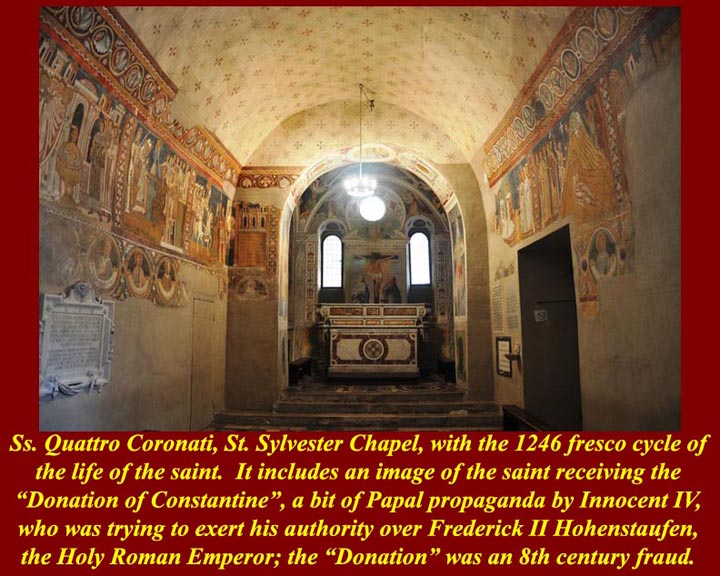
http://www.mmdtkw.org/MedRom0902xQuattroCoronati2.jpg
http://www.mmdtkw.org/MedRom0902yQuattroCoronati1.jpg
Ss. Quattro Coronati Church on the street that runs between the Colosseum and St. John Lateran has an papal chapel dedicated to Sylvester, the pope who was said to have converted and baptized Constantine. In the chapel, as we have seen, is a 1246 fresco cycle showing incidents in Sylvester's life, including a bit of 13th century papal propaganda: Constantine is shown kneeling before Sylvester and giving him the famous "Donation". The fresco was painted at a time when Innocent IV was trying to exert authority over Frederick II Hohenstaufen, the Holy Roman Emperor. In fact, however, the Donation was a forgery. (Another legendary incident shown in the fresco cycle is Sylvester curing Constantine of leprosy.) There is also no evidence that Constantine and Sylvester ever met.
http://www.mmdtkw.org/MedRom0902zQuattroCoronati3.jpg
In a balcony of the church, another fresco cycle from the 1200s has been found and 350 square meters have been uncovered and restored.
http://www.mmdtkw.org/MedRom0903aaLateMedievalArtists.jpg
For a more comprehensive list of proto-renaissance artists, see
https://simple.wikipedia.org/wiki/Later_medieval_artists.
http://www.mmdtkw.org/MedRom0903ApseMosaicMMagg.jpg
Jacopo Torriti's apse mosaic in S. Maria Maggiore
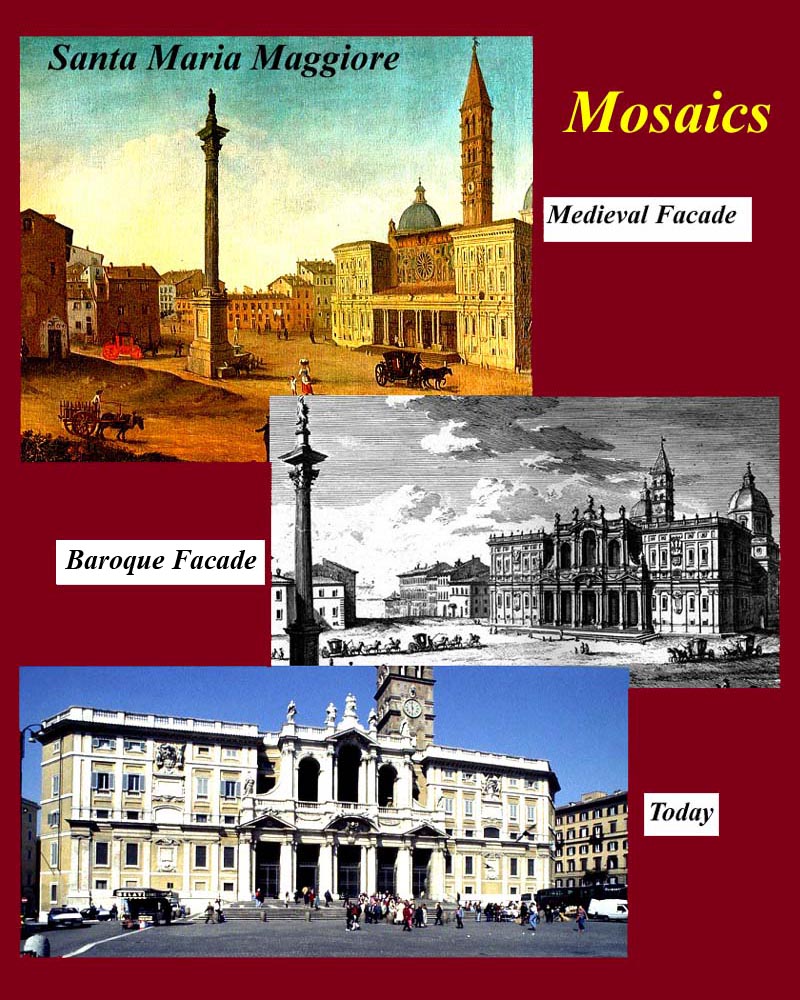
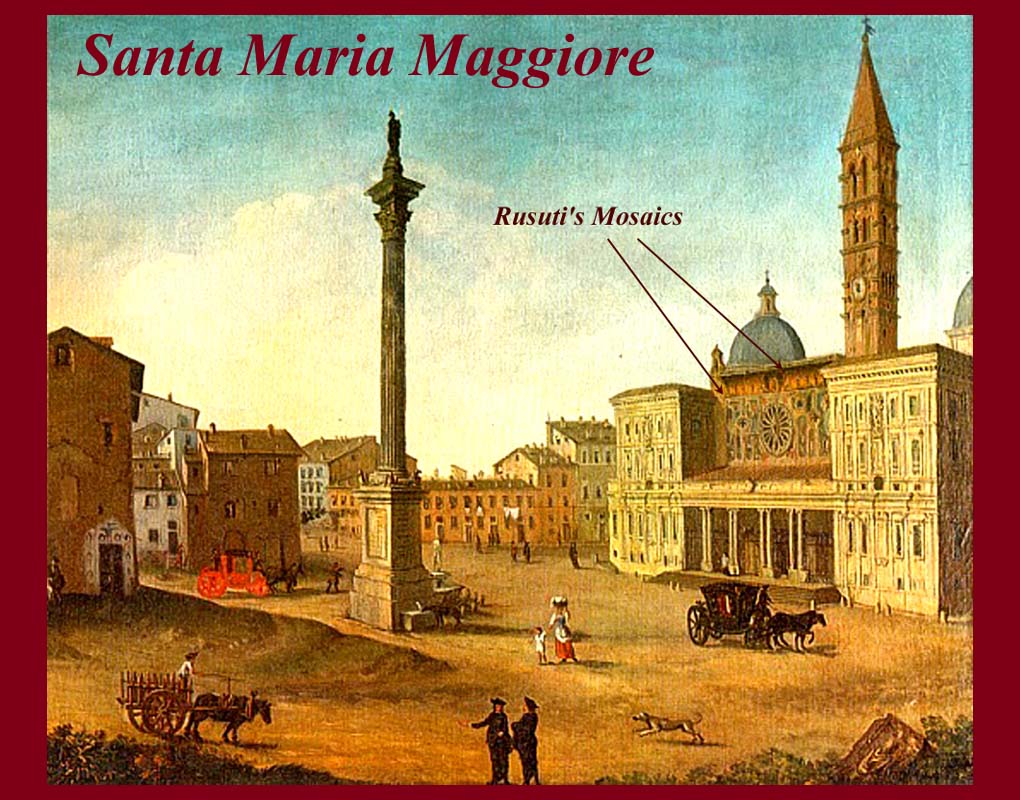
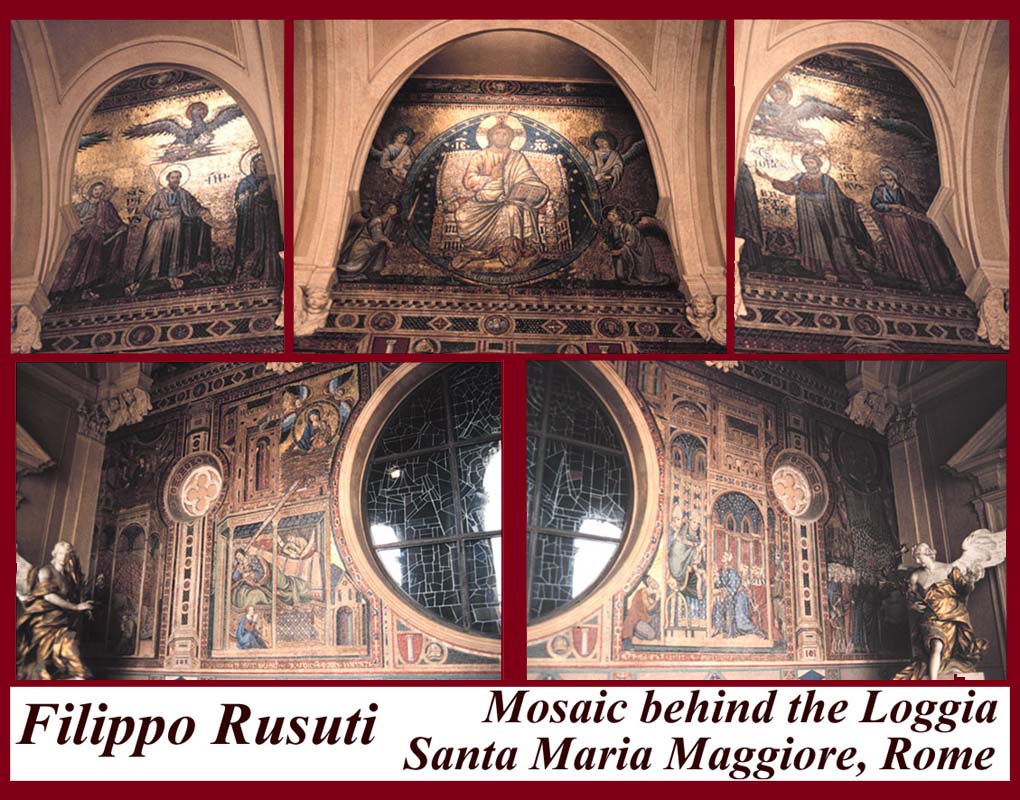
http://www.mmdtkw.org/MedRom0904SMMaggioreEvol.jpg
http://www.mmdtkw.org/MedRom0905RusutiMMaggiore1.jpg
http://www.mmdtkw.org/MedRom0906RusutiMMaggiore2.jpg
http://www.mmdtkw.org/MedRom0907RusutiMMaggiore3.jpg
Rusuti facade mosaic, S. M. Maggiore
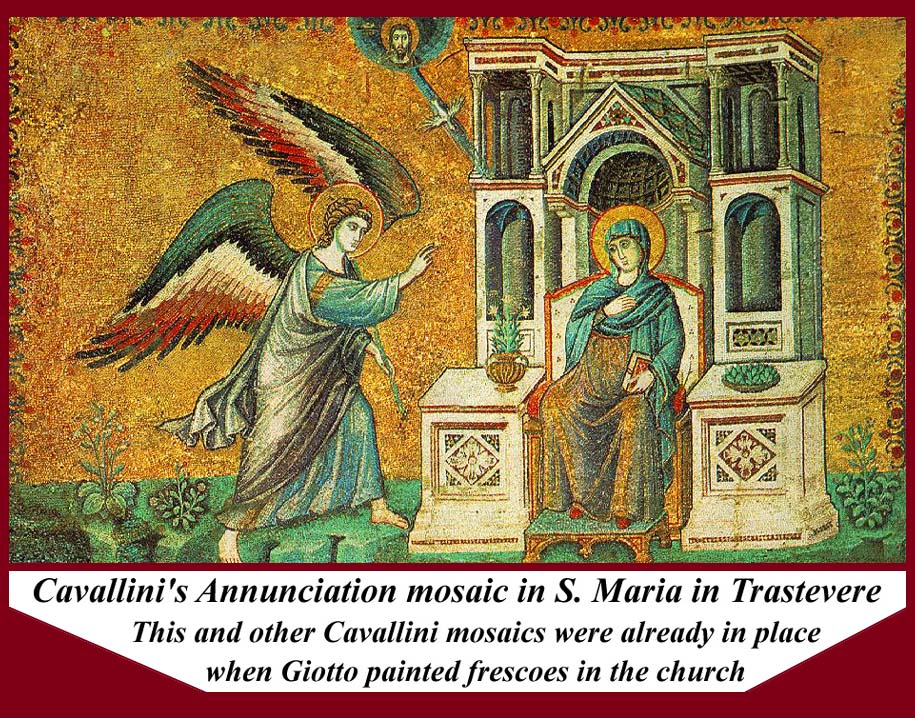
http://www.mmdtkw.org/MedRom0908CavAnnunciaSMTras.jpg
http://www.mmdtkw.org/MedRom0909CavMaryJesuSMTras.jpg
Cavallini's Annunciation and the Births of Mary and Jesus, mosaic cycle of the life of Mary, S. Maria in Trastevere -- these and other Cavallini mosaics were already in place when Giotto painted frescoes in the Church.
http://www.mmdtkw.org/MedRom0910CavaJudgeSCecilia.jpg
Cavallini's Last Judgment fresco, Santa Cecilia in Trastevere was covered over and then hidden behind the nuns' choir in the back of the church. The angel is from the annunciation -- Cavallini's angels almost always had multi-colored wings.
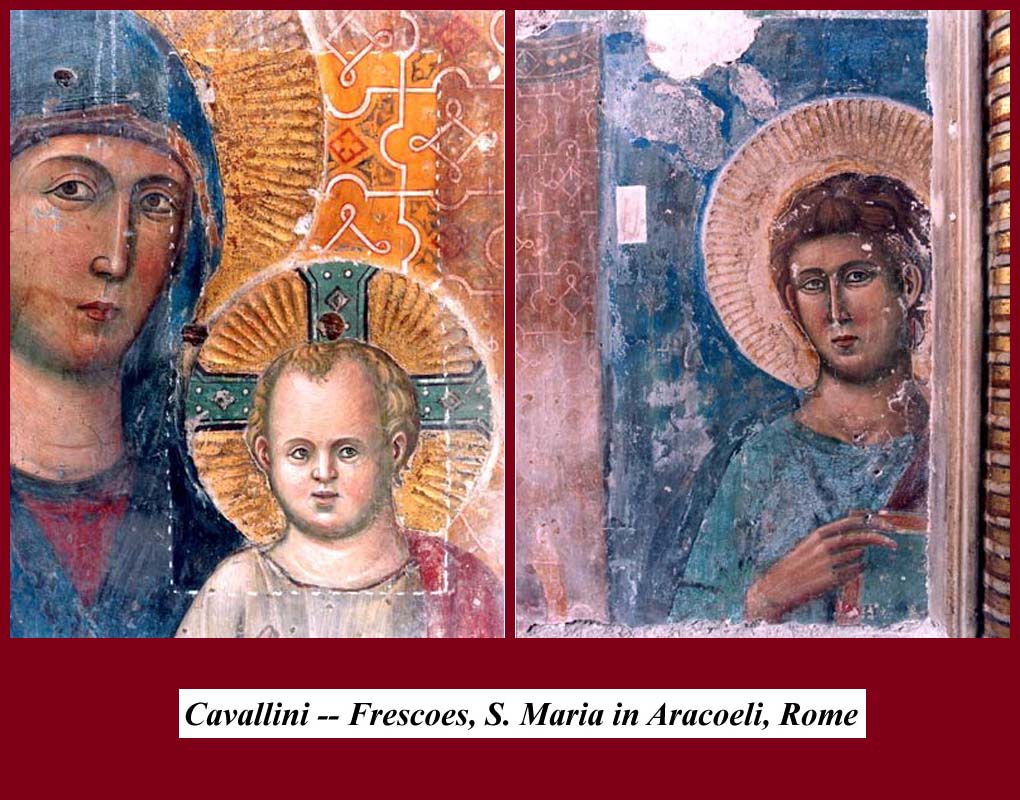
http://www.mmdtkw.org/MedRom0911CavaliniAracoeli1.jpg
http://www.mmdtkw.org/MedRom0912CavaliniAracoeli2.jpg
Recently rediscovered Cavallini frescoes in S. Maria in Araceoli. At some point Cavallini's fresco was painted over with a painting by one of the renaissance Caravaggisti. It was known that Cavallini had decorated the church, but it was thought that his frescoes had been destroyed during a renaissance redecoration. The Cavallini frescoes were rediscovered in 2000 by Tommasso Strinati, an art historian from the University of Rome.
(a)
(b)
(c)
http://www.mmdtkw.org/MedRom0913AssisiCimabue1.jpg
http://www.mmdtkw.org/MedRom0914Assis1Cimabue2.jpg
http://www.mmdtkw.org/MedRom0915AssisiCimabue3.jpg
(a) and (b) Cimabue's frescoes in St. Francis (lower church) Assisi.
(c) Cimabue's frescoes in St. Francis (upper church) Assisi.
According to biographer Giorgio Vasari, Giotto was a student and employee of Cimabue.
http://www.mmdtkw.org/MedRom0921CimabueOtherWorks.jpg
(The images are computer enhanced for easier visibility.)
Other works by Cimabue:
Pisa Apse Mosaic -- https://commons.wikimedia.org/wiki/Category:Cathedral_(Pisa)_-_Mosaic_of_Christ_Pantocrator
Uffizi Madonna -- https://www.virtualuffizi.com/santa-trinita-madonna.html
Washington Nationa Gallery Madonna and Child -- https://www.nga.gov/Collection/art-object-page.41675.html
Crucifix -- http://www.travelingintuscany.com/art/cimabue/arezzocrucifix.htm
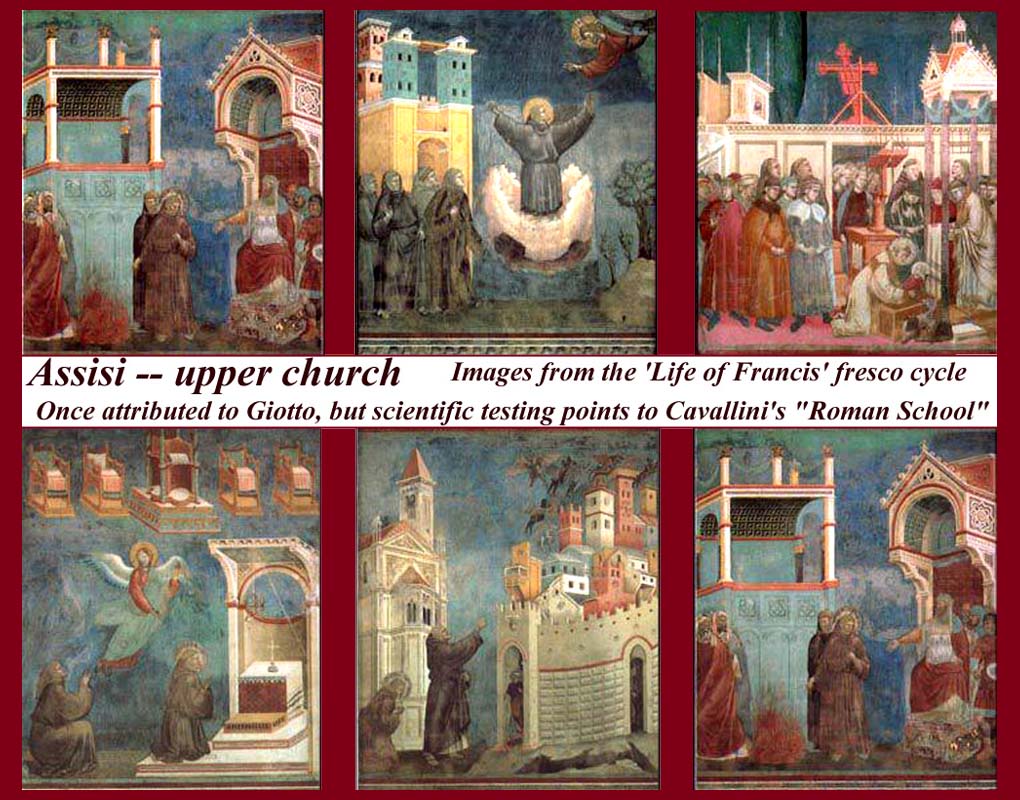
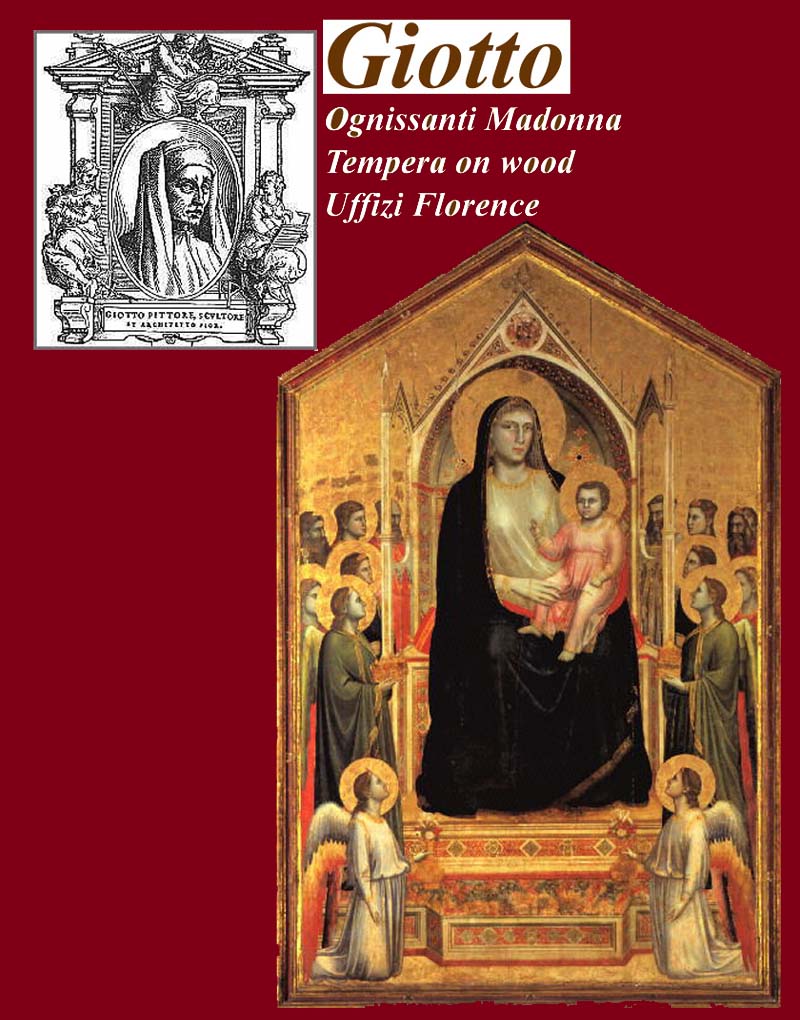
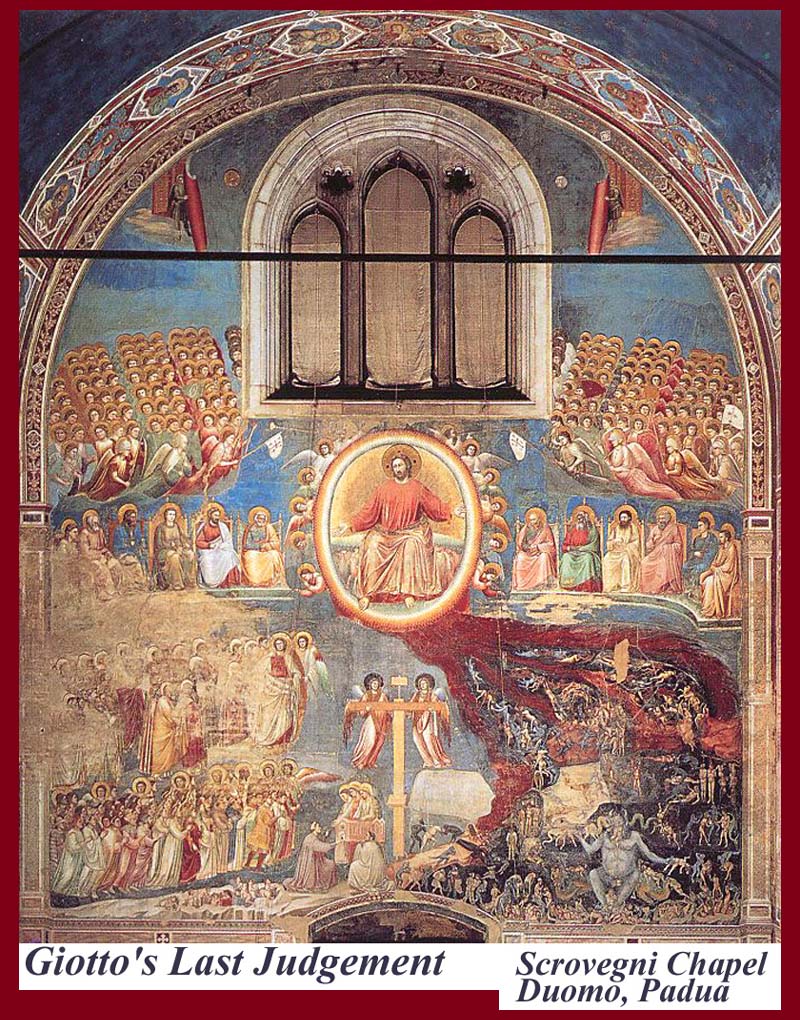
http://www.mmdtkw.org/MedRom0916FrancisCycAssisi.jpg
http://www.mmdtkw.org/MedRom0917UffizGiotto.jpg
http://www.mmdtkw.org/MedRom0919GiottoJudgement.jpg
http://www.mmdtkw.org/MedRom0920GiottoPadua-m.jpg
Six of the 28 images in the if the fresco cycle of the life of St. Francis in the upper church in Assisi (-- all 28 are on line at http://housebarra.com/PastTimes/stfrancis/http://housebarra.com/PastTimes/stfrancis/). They were, since the time of biographer Giorgio Vasari, thought to be the work of Giotto, but they are now ascribed to Cavallini based on stylistic grounds and on pigment analysis. The St. Francis frescoes are not in the same style as Goitto's in the Scrovegni chapel on the Padua duomo which were painted by Giotto at the same time that the St. Francis frescoes were painted. And that's another problem -- while he was supposed to be painting in Assisi (if the Francis frescoes were his) he was recorded as working in Padua.
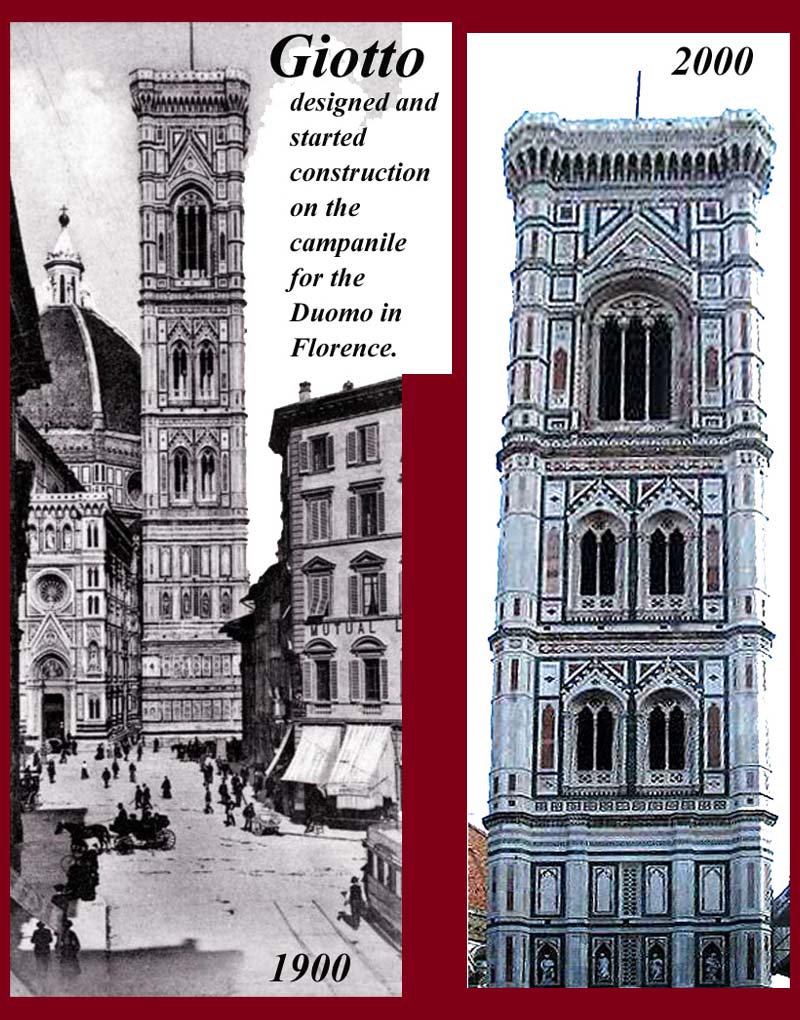
http://www.mmdtkw.org/MedRom0918GiottoFloCampanil.jpg
http://www.mmdtkw.org/MedRom0918xGiottoCampanileSpire.jpg
Giotto's campanile at the Duomo in Florence was his masterpiece. His design was in harmony with the polychromy of the cathedral, as applied by Arnolfo di Cambio, making the tower look as if it were “painted”. Instead of a filigree skeleton of a Gothic building, he applied a surface of colored marble in geometric patterns.
When he died in 1337, Giotto had only finished the lower floor with its marble external revetment: geometric patterns of white marble from Carrara, green marble from Prato and red marble from Siena. The tall Gothic spire that Giotto envisioned for the top of his campanile was never built. It would have made the tower half again as high as it is.
Through this work, the painter Giotto became, together with Brunelleschi (dome of the cathedral of Florence) and Alberti (with his treatise De re aedificatoria, 1450), one of the founding fathers of Italian Renaissance architecture.
See http://allart.biz/up/photos/album/G/Giotto%20di%20Bondone/giotto_di_bondone_16_campanile.jpg, and for an image of the whole of Giotto's drawing for the Campanile, which is in the Duomo's Museo dell'Opera del Duomo,
Letters
http://www.mmdtkw.org/MedRom0922aaLegendaAurVorag.jpg
Late-medieval best-seller: The Golden Legend (Latin: Legenda aurea or Legenda sanctorum) is a collection of fanciful hagiographies by Jacobus de Voragine that became a late medieval bestseller. It was likely compiled around the year 1260. Initially entitled Legenda sanctorum (Readings of the Saints), it gained its popularity under the title by which it is best known. It overtook and eclipsed earlier compilations of abridged legendaria, the Abbreviatio in gestis et miraculis sanctorum attributed to Jean de Mailly and the Epilogus in gestis sanctorum of the Dominican preacher Bartholomew of Trent. Over eight hundred manuscript copies of the work survive, and when printing was invented in the 1450s, editions appeared quickly, not only in Latin, but also in every major European language. Among incunabula, printed before 1500, Legenda aurea was printed in more editions than the Bible.
For information on Voragine, see http://en.wikipedia.org/wiki/Jacobus_de_Voragine.
The operative word on the Golden Legend is "fanciful". For translations, see http://sourcebooks.fordham.edu/halsall/basis/goldenlegend/index.asp.
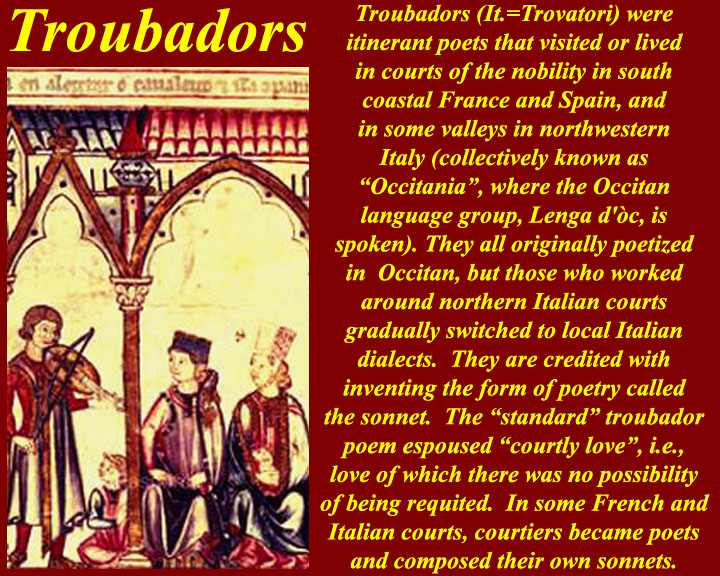
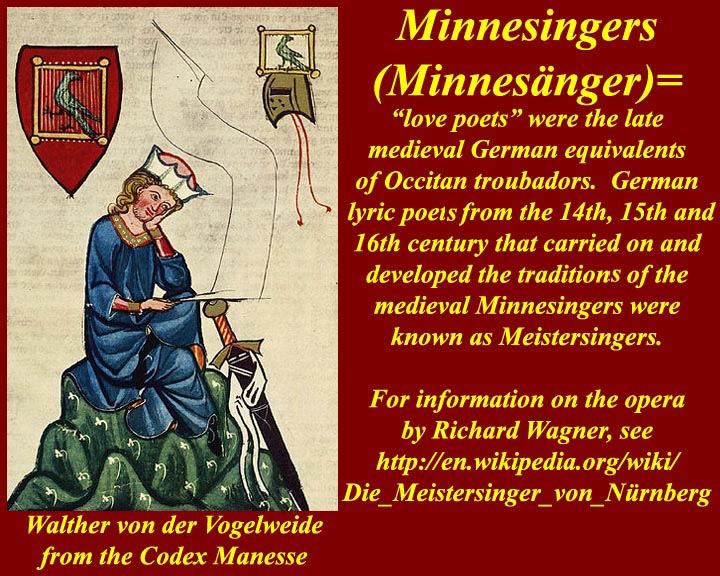
http://www.mmdtkw.org/MedRom0922aTroubadour.jpg
http://www.mmdtkw.org/MedRom0922bMinnesanger.jpg
http://www.mmdtkw.org/MedRom0922cTrovatoreVerdi.jpg
Much of Italian literature, particularly of the poetic type, sprang from the troubadours of France. Other parts of France also had troubadours, but the ones that interacted with the Italians were from southeast France in the provinces of the Papal properties around Avignon. A similar tradition developed in 12th through 14th century Germany among the Minnesingers. (It is a common misconception that the word minnesinger is a somehow diminutive form in opposition to somehow larger or more important meistersingers. Minnesinger actually derives from the word minne, Middle High German for love which was their main subject, and an individual song was a minnelied.) The main transmitter of the troubadour poetic tradition to the Italians is considered to have been Petrarch who picked up their style of poetry while resident in Avignon. The short poems that Perarch wrote in the troubadour style were called "little songs" = sonette = sonnets.
http://www.mmdtkw.org/MedRom0922dDolceStilNovo.JPG
The image is a 19th century imagining of Dante seeing his beloved Beatrice on the Lung'Arno in Florence. In his lyric works, Dante mastered the dolce stil novo ("sweet new style") of a group of 13th to 14th century century mostly Florentine poets, whose vernacular sonette, canzoni and ballate celebrated a spiritual and idealized view of love and womanhood in a way that was sincere, delicate, and musical. The most brilliant poets of the group were Guido Cavalcante and Dante himself.
The importance of the dolce stil novo lies in the fact that. apart from being the manifestation of the first true literary tradition in Italy, it ennobled the Tuscan vernacular, which was soon destined to become the Italian national language. Dolce stil novo was given its name by Dante himself in his Divine Comedy.
For a bit more on the dolce stil novo, see http://en.wikipedia.org/wiki/Dolce_Stil_Novo.
http://www.mmdtkw.org/MedRom0922LatiniDante.jpg
Brunetto Latini and Dante in a Giotto fresco, Bargello Chapel, Florence.
See http://en.wikipedia.org/wiki/Brunetto_Latini and http://www.newadvent.org/cathen/09034a.htm, and http://danteworlds.laits.utexas.edu/textpopup/inf1501.html.
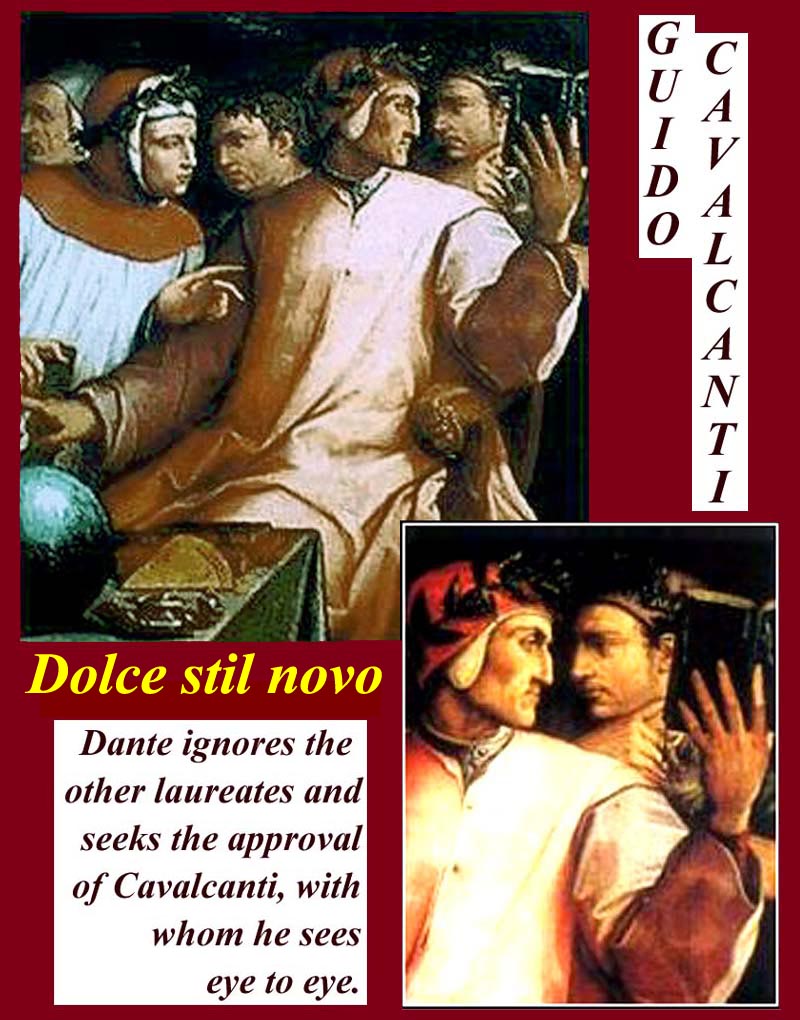
http://www.mmdtkw.org/MedRom0923CavalcantiDante.jpg
http://www.mmdtkw.org/MedRom0923xSixTuscanPoets.jpg
Dante with Guido Cavalcante, his "intimate friend". (Nothing homoerotic is necessarily implied. These people were all into Platonic rather than Erotic love.)Cavalcanti had his Vanna (Giovanna) just as Dante had his Beatrice and Petrarch his Laura. Cavalcante is often considered "second best" to Dante in the dolce stil novo.
See http://en.wikipedia.org/wiki/Guido_Cavalcanti.
For Ezra Pound's translations, see http://www.sonnets.org/pound.htm.
http://www.mmdtkw.org/MedRom0924CastagnoDante.jpg
Dante (= Durante) Alighieri: Dante fresco by Andrea del Castagno, Cenacolo di Sant'Andrea, Florence.
See http://www.worldofdante.org/,
http://en.wikipedia.org/wiki/Dante_Alighieri, and
http://www.greatdante.net/.
For his works, see http://www.worldofdante.org/.
(a)
(b)
(c)
http://www.mmdtkw.org/MedRom0925DanteCosmplogy.jpg
http://www.mmdtkw.org/MedRom0926DantePoema.jpg
http://www.mmdtkw.org/MedRom0927BottIcelliInferno.jpg
(a) Dante's cosmology, from an edition of the Divine Comedy.
(b) Dante and his Poem, Renaissance painting by Domenico di Michelino (1460).
(c) Botticelli illustration (colored in by the artist) for a copy of the Dante Inferno.
http://www.mmdtkw.org/MedRom0927xAbandonLaptops.jpg
New Inferno.
http://www.mmdtkw.org/MedRom0928PetrarchLaura.jpg
Petrarch and his Laura (Petrarch fresco by Andrea del Castagno, Cenacolo di Sant'Andrea, Florence).
Laura was the love of Petrarch's life. For her he perfected the sonnet and wrote the Canzoniere.
Who Laura was and even if she really existed is a bit of a mystery. It has often been believed that the name "Laura" was a play on the word "laurel" the leaves which Petrarch was honoured with for being the poet laureate.
However, there is some evidence that Laura really did exist and that she was Laure de Noves.
http://www.mmdtkw.org/MedRom0929PetrarcaCoronato.jpg
1341 Coronation of Petrarch as Rome's first poet laureate in centuries, crowned by Robert of Naples on the Campidoglio in Rome -- taken by some to be the first act of the Renaissance.
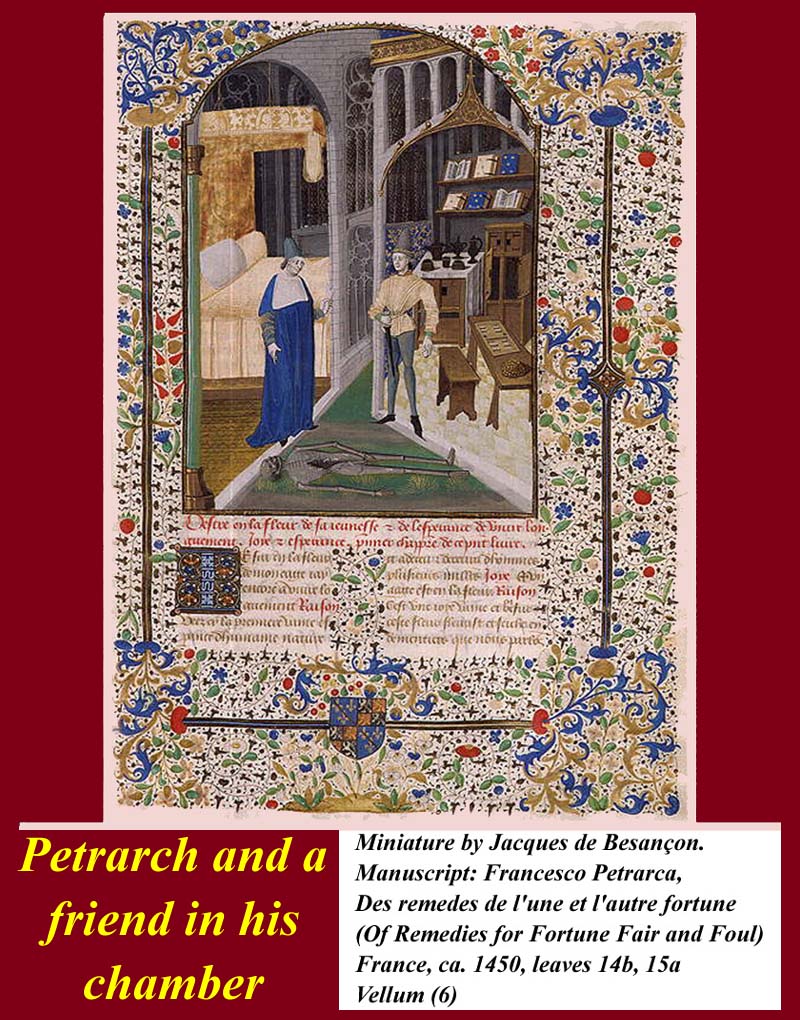
http://www.mmdtkw.org/MedRom0930PetrarchFriend.jpg
Miniature by Jaques de Besancon from a manuscript copy of Petrarch's Des remedees de l'une et l'autre fortune, France, ca. 1450.
Petrarch wrote Of Remedies for Fortune Fair and Foul in 1365. Cast in the form of dialogues between Reason and Agony, Petrarca's work offers advice on thinking clearly in times of happiness and sorrow.
See http://petrarch.petersadlon.com/ (includes works),
http://en.wikipedia.org/wiki/Petrarch, and
http://en.wikipedia.org/wiki/Laura_de_Noves.
http://www.mmdtkw.org/MedRom0931CastagnoBoccaccio.jpg
Boccaccio fresco by Andrea del Castagno, Cenacolo di Sant'Andrea, Florence (This fresco now removed to the Uffizi Museum in Florence).
See http://en.wikipedia.org/wiki/Giovanni_Boccaccio,
http://www.newadvent.org/cathen/02607a.htm, and
http://www.brown.edu/Departments/Italian_Studies/dweb/the_project/ (includes texts).
http://www.mmdtkw.org/MedRom0932BoccaccioAudience.jpg
Miniature from Boccaccio's Des cas des nobles hommes et femmes, France, ca 1520.
Concerning the Fates of Illustrious Men and Women, written by Florentine poet and man of letters Giovanni Boccaccio, was one of the most popular literary works among the French aristocracy in the 1400s. Boccaccio's book was a collection of stories about exemplary heroes and heroines from biblical, classical, and medieval history. Laurent de Premierfait, who undertook this French translation (Des cas des nobles hommes et femmes), added additional tales from both ancient and more recent sources to Boccaccio's. All but one of the miniatures in this volume were painted by the Boucicaut Master, one of the finest Parisian illuminators of the early fifteenth century, and his workshop of highly trained collaborators. In his framed miniatures, the Boucicaut Master used newly developed and highly saturated colors that were very expensive at the time. The high quality of the illuminations and the scale of the decoration suggest that this book was made for someone in the court circle of King Charles VI of France.
http://www.mmdtkw.org/MedRom0933WaterhouseDecam.jpg
Image: John William Waterhouse (British, 1849 - 1917), A Tale from the Decameron 1916), oil on canvas, Lady Lever Art Gallery, Liverpool.
The Decameron (subtitle: Prencipe Galeotto) is a collection of 100 novellas by Italian author Giovanni Boccaccio, probably begun in 1350 and finished in 1353. It is a medieval allegorical work best known for its bawdy tales of love, appearing in all its possibilities from the erotic to the tragic. Some believe many parts of the tales are indebted to the influence of The Book of Good Love. Many notable writers, such as Geoffrey Chaucer, are said to have drawn inspiration from The Decameron (See Literary sources and influence of the Decameron below).
The title is a portmanteau of two Greek words meaning "ten" (δέκα déka) and "day" (ἡμέρα hēméra).
Full texts of the Decameron in English:
http://www.brown.edu/Departments/Italian_Studies/dweb/texts/DecIndex.php?lang=eng (English)
See also
http://en.wikipedia.org/wiki/The_Decameron,
http://en.wikipedia.org/wiki/The_Book_of_Good_Love.

